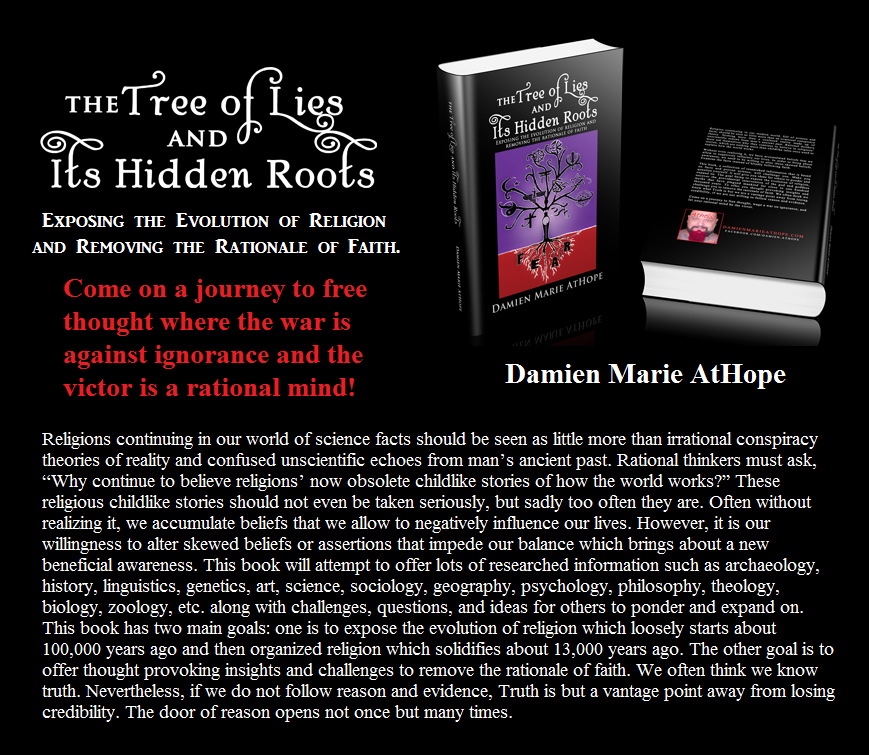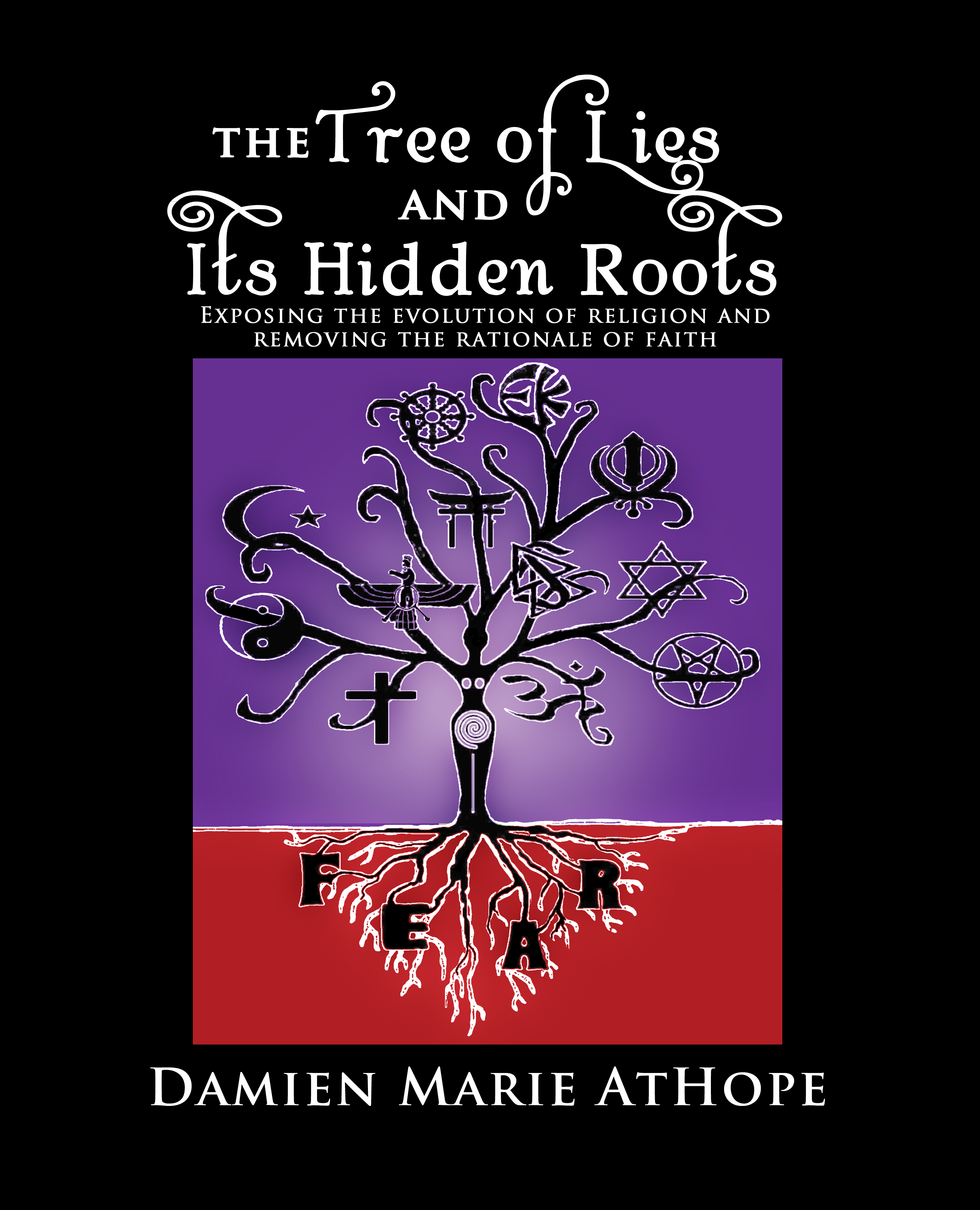
Art by Damien Marie AtHope
My Approach to Religion?
I have been told by several scholarly friends ranging from archaeologists, anthropologists, historians, and ethnographers that they generally approach religion from a limited approach.
But I like a multimodality approach to Religion origins, mainly use thinking from archaeology, anthropology, ethnography, prehistoric-art/architecture, linguistics, and generics.
My degree is in psychology (with some training in sociology, multicultural criminology and juvenile delinquency, teaching, intervention, alcohol, and drug addiction therapy as well) and I had excellent grades and was doing great but I dropped out of my masters after 7 classes, to do the new desire to research the origins and evolution of religion around the whole Earth and throughout all time, which is an adventure that has taken over 10 years ago to research for my book: “The Tree of Lies and its Hidden Roots” not yet published. I was in college to be a mental health therapist, which I would have enjoyed. Unlike the shit, I have to endure as the out activist, like I am now. In fact, I would likely be financially well off but instead, I chose humanity and possible poverty if needed in order to help change the world as much as I can. It was the work mistake of my life but the proudest thing I have ever done in my life. We rise by helping each other. The pain of the mind is some of the most lasting pain just as freedom of the mind is some of the most lasting freedom. May I be someone who can make anyone feel like someone of value. Human-Kind. Be both…
I am virtuous to the vulnerable and champion justice, so valiantly, as I have experienced the hateful lash of unkindness and wish to champion its opposite, radical kindness in an unkind world, a sigh of true bravery. It seems that there are two main types of philosophers: Thinkers and Specialists, and I have always thought of myself as a thinker. I understand things often at a very deep level, and yet I can generally explain them in a low-level way if needed as well. I am open to doing recorded video chats or even presentations for a group I have presented to several times before and am quite comfortable doing them. I have commonly done talks for free for atheist groups, organizations, or even anthem meetups. I enjoy helping others.
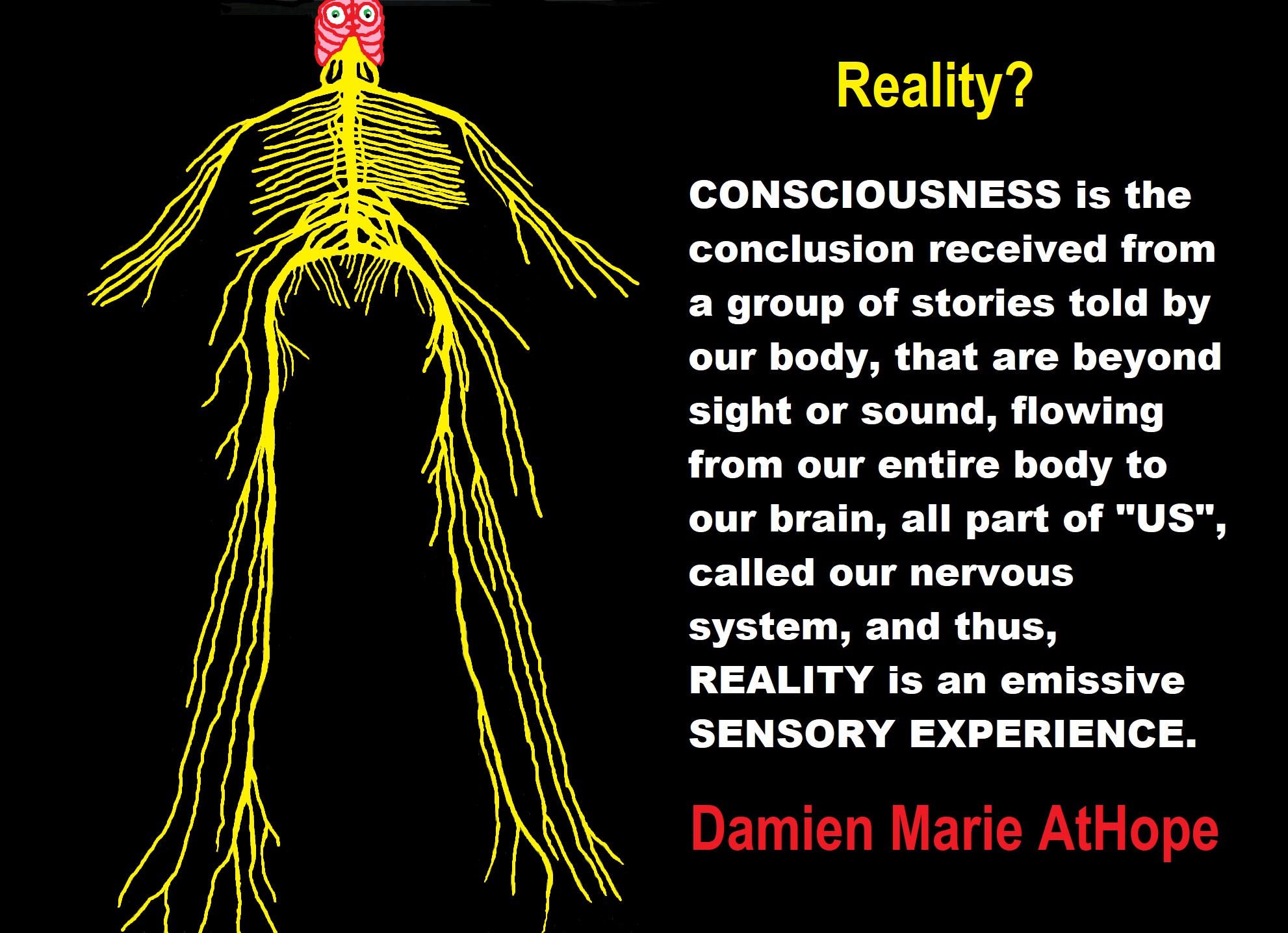
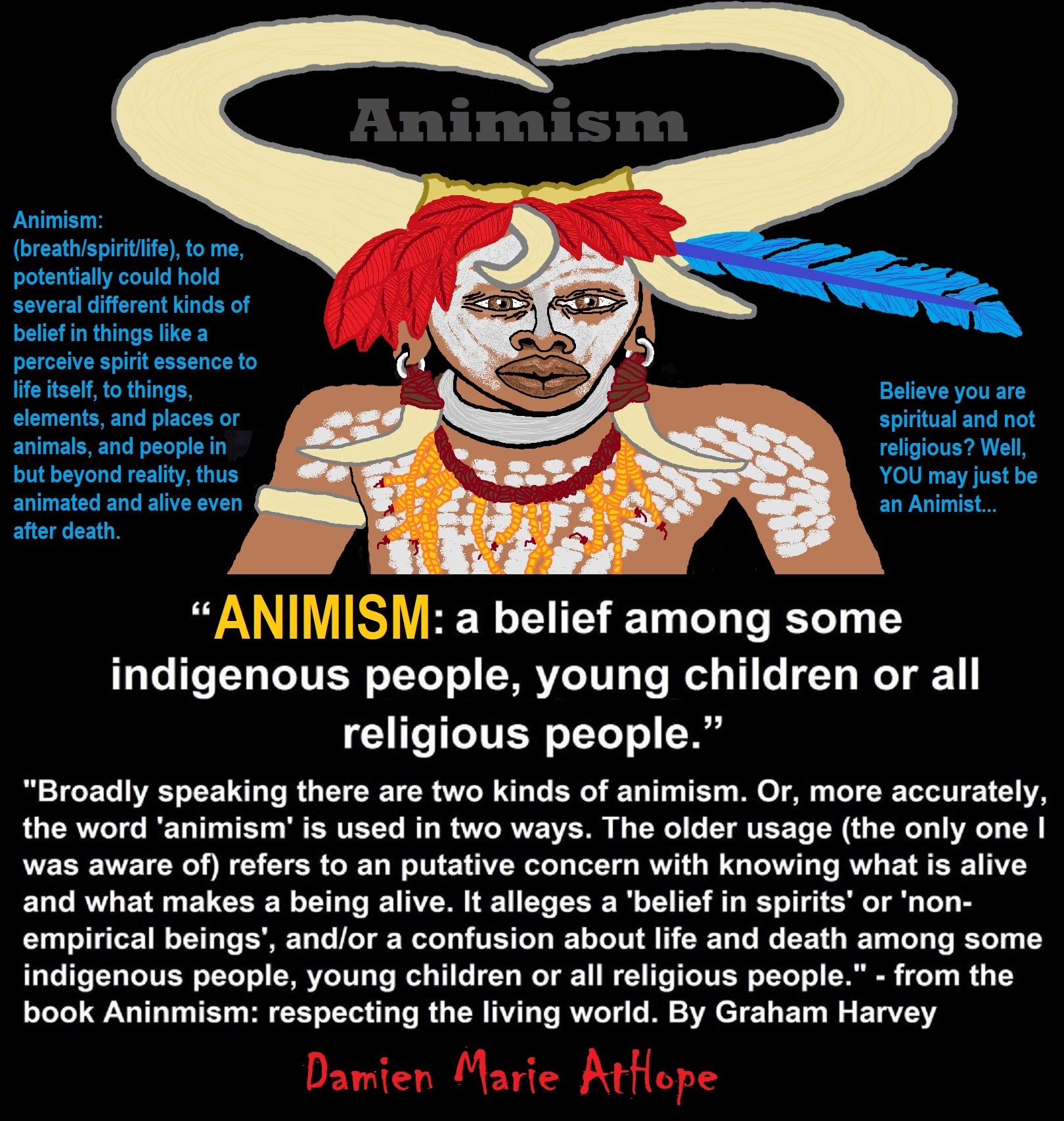
Animism: Respecting the Living World by Graham Harvey
“How have human cultures engaged with and thought about animals, plants, rocks, clouds, and other elements in their natural surroundings? Do animals and other natural objects have a spirit or soul? What is their relationship to humans? In this new study, Graham Harvey explores current and past animistic beliefs and practices of Native Americans, Maori, Aboriginal Australians, and eco-pagans. He considers the varieties of animism found in these cultures as well as their shared desire to live respectfully within larger natural communities. Drawing on his extensive casework, Harvey also considers the linguistic, performative, ecological, and activist implications of these different animisms.” ref

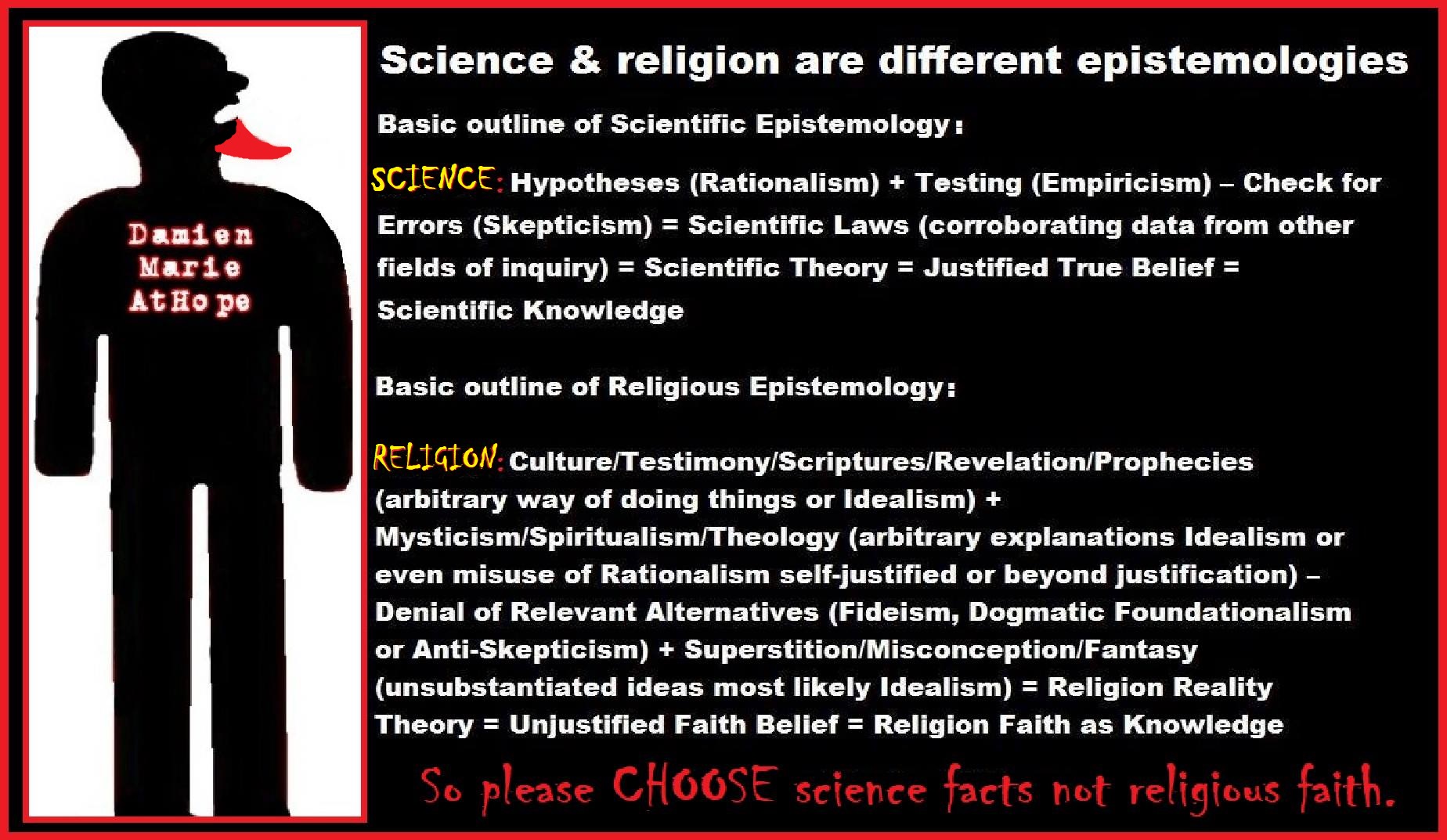
Creationists think of species as being formed independent of each other over just a couple of days, a few thousand years ago. In reality, every species we see are an extension of the most ancient forms of life branching out in endlessly varied forms. We tend to think of species as fixed, settled, but they are plastic and malleable, constantly adapting for a variety of natural reasons.

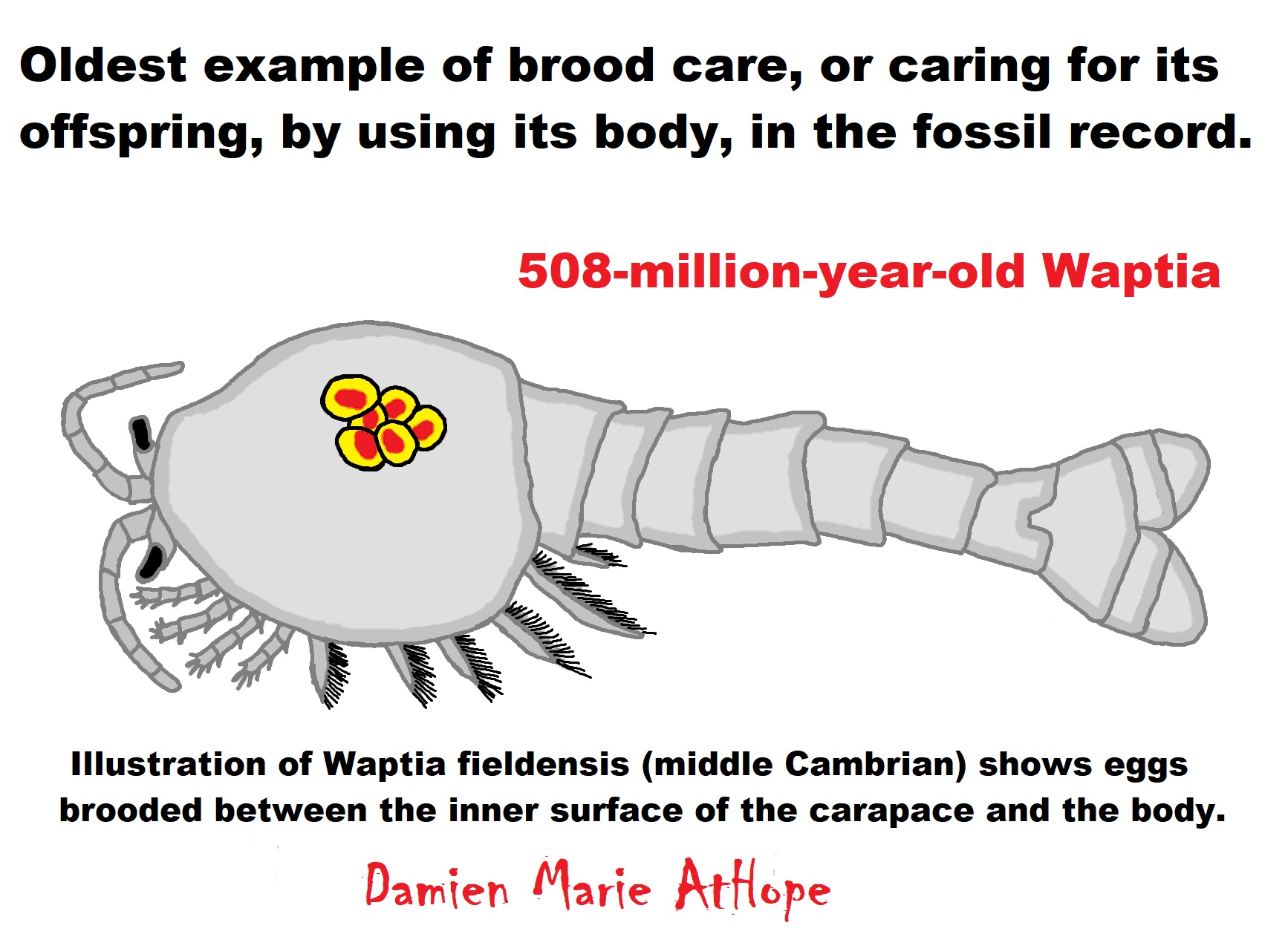

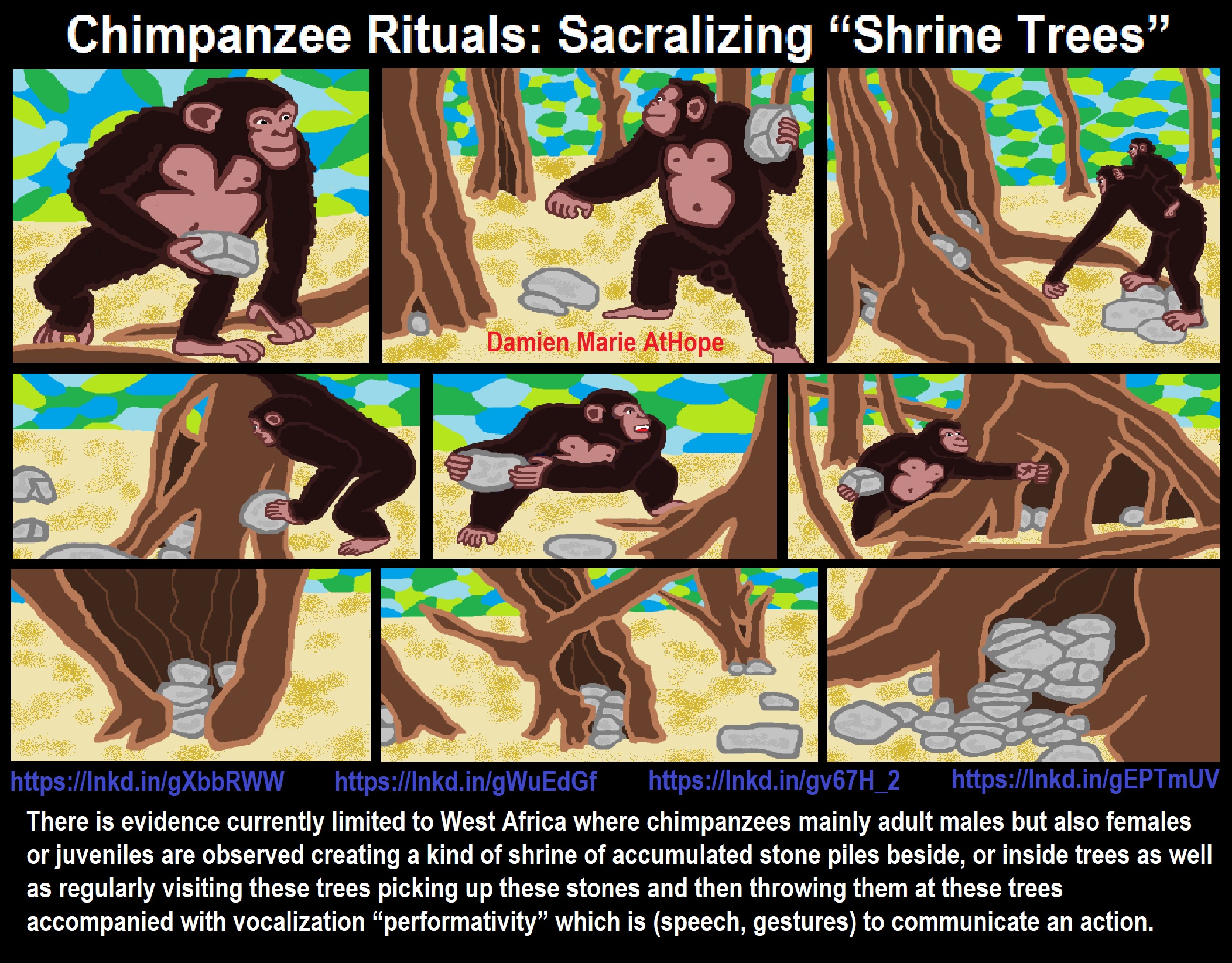
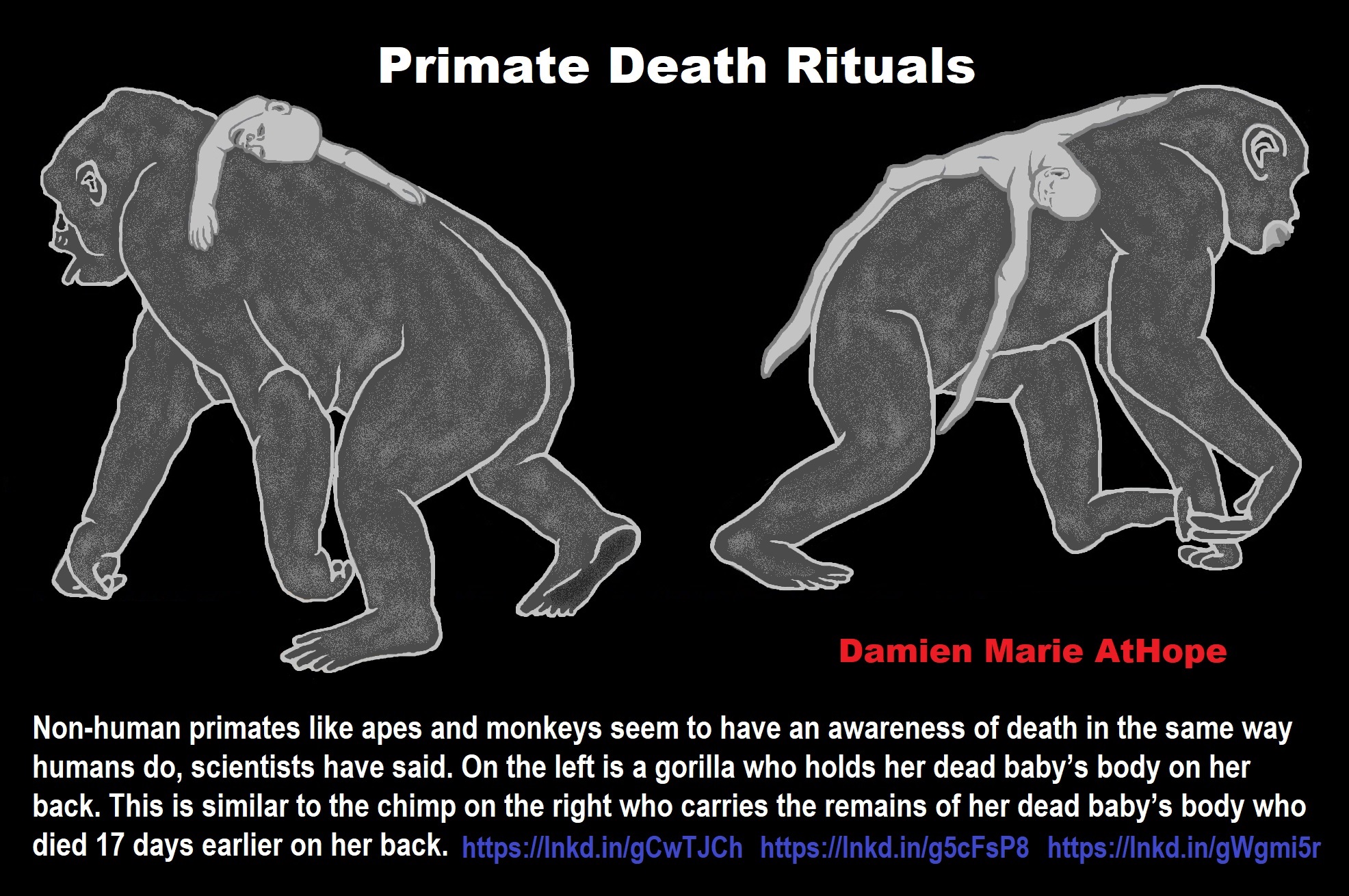

“Wonderwerk Cave is an archaeological site, in the Kuruman Hills, situated between Danielskuil and Kuruman in the Northern Cape Province, South Africa, dating suggests that basal sediment entered the cave some 2 million years ago. Evidence within Wonderwerk cave has been called the oldest controlled fire with what is thought to be Fire-Making by about 1.7 Million Years Ago. Moreover, evidence for fire-making ranges from the end of the Later Stone Age to the very base of the Acheulean. That discovery is seen to be in accord with findings from four other regional sites, which together provide evidence that can be construed as support for fire-making over almost the same time span.” ref, ref
“A handaxe (or hand ax) is a prehistoric stone tool with two faces that is the longest-used tool in human history. Hand axe tools were possibly used to butcher animals; to dig for tubers, animals, and water; to chop wood and remove tree bark; and/or process vegetal materials. Other scholars have proposed that hand axes were used to throw at prey; for a ritual or social purpose; or possibly as a source for flake tools. Moreover, No academic consensus describes their use, but it is commonly agreed that the hand axe was some form of unhafted all-purpose tool. The pioneers of Palaeolithic tool studies first suggested that bifaces were used as axes despite the fact that they have a sharp border all around. Other uses seem to show that hand axes were a multi-functional tool, leading some to describe them as the “Acheulean Swiss Army knife“. Other academics have suggested that the hand axe was simply a byproduct of being used as a core to make other tools, a weapon, and/or was perhaps used ritually.” ref
“Evidence for unusual symbolic activity in Wonderwerk date to around 400,000–500,000 years ago, which predates Middle Stone Age sites like Blombos Cave deposits that currently date at between c. 100,000 and 70,000 years ago.” ref, ref



430,000 years ago, Sima de los Huesos, “Pit of Bones”, Atapuerca, Spain, seeming evidence of intentional storing of 28 individuals in a cave chamber pit (a symbolic pseudo-womb?) and a reddish quartzite tool found with the bodies, seems like a kind of ritual funeral offering in this possibly early cemetery. Fossil remains of 430,000-400,000-years-old 28 individuals, 6,500 bone fragments and 500 teeth, in one of several important sections of the Cueva Mayor-Cueva del Silo cave system in north-central Spain. The bone pit is at the bottom of the cave, beneath an abrupt vertical shaft measuring between 6.5-13 feet in diameter, and located about .1/3 of a mile in down a 42.5 ft shaft and it is possibly an expression of mortuary practices. ref
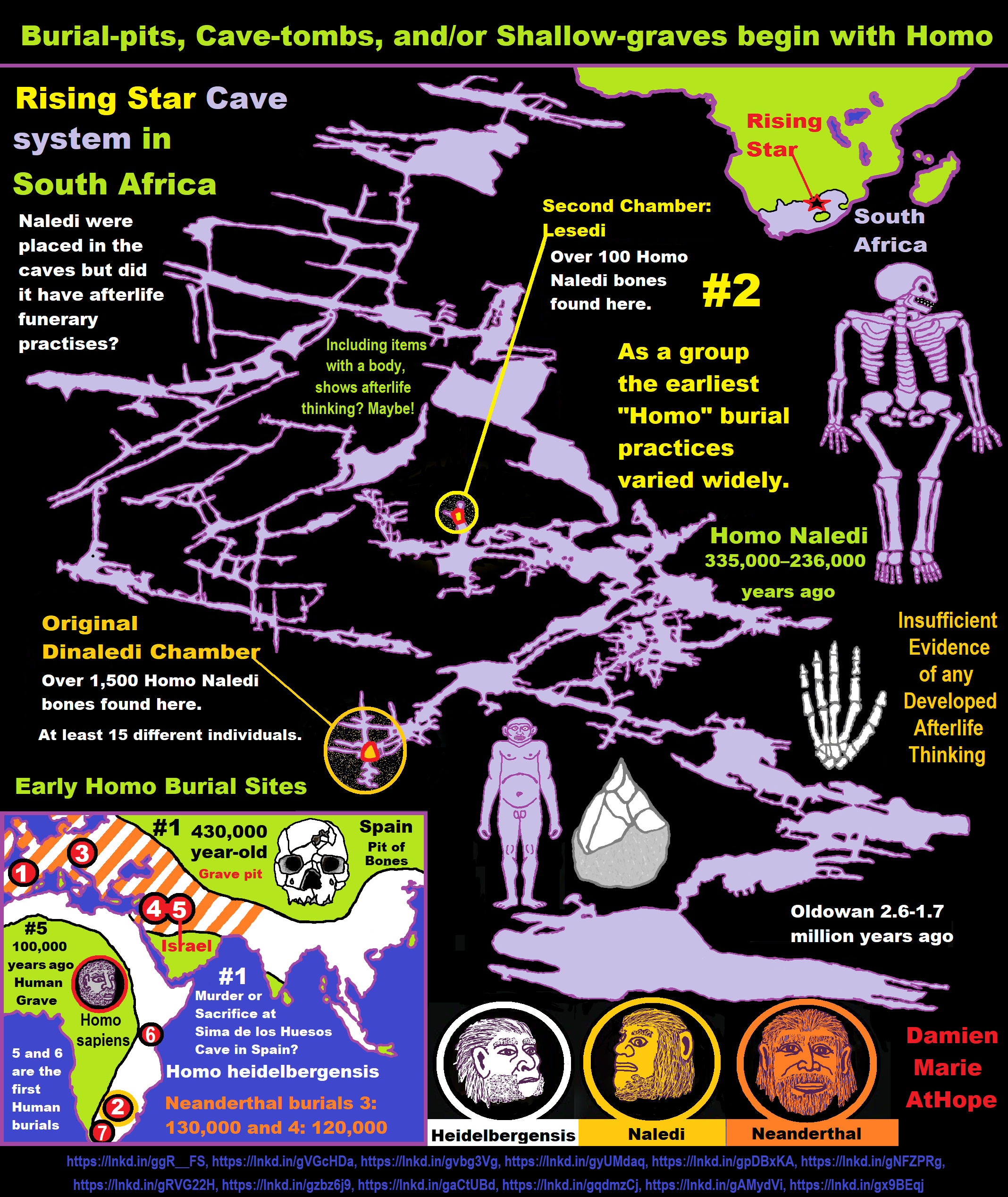
ref, ref, ref, ref, ref, ref ,ref ,ref ,ref ,ref, ref, ref
Homo Naledi
“Homo Naledi is a species of archaic human discovered in the Rising Star Cave, Cradle of Humankind, South Africa dating to the Middle Pleistocene 335,000–236,000 years ago. The initial discovery comprises 1,550 specimens, representing 737 different elements, and at least 15 different individuals. Despite this exceptionally high number of specimens, their classification with other Homo remains unclear.” ref
“Along with similarities to contemporary Homo, they share several characteristics with the ancestral Australopithecus and early Homo as well (mosaic anatomy), most notably a small cranial capacity of 465–610 cm3 (28.4–37.2 cu in), compared to 1,270–1,330 cm3 (78–81 cu in) in modern humans. They are estimated to have averaged 143.6 cm (4 ft 9 in) in height and 39.7 kg (88 lb) in weight, yielding a small encephalization quotient of 4.5. Nonetheless, Homo Naledi’s brain anatomy seems to have been similar to contemporary Homo, which could indicate equatable cognitive complexity. The persistence of small-brained humans for so long in the midst of bigger-brained contemporaries revises the previous conception that a larger brain would necessarily lead to an evolutionary advantage, and their mosaic anatomy greatly expands the known range of variation for the genus.” ref
“Homo Naledi anatomy indicates that, though they were capable of long-distance travel with a humanlike stride and gait, they were more arboreal than other Homo, better adapted to climbing and suspensory behavior in trees than endurance running. Tooth anatomy suggests consumption of gritty foods covered in particulates such as dust or dirt. Though they have not been associated with stone tools or any indication of material culture, they appear to have been dextrous enough to produce and handle tools, and likely manufactured Early or Middle Stone Age industries. It has also been controversially postulated that these individuals were given funerary rites, and were carried into and placed in the chamber.” ref
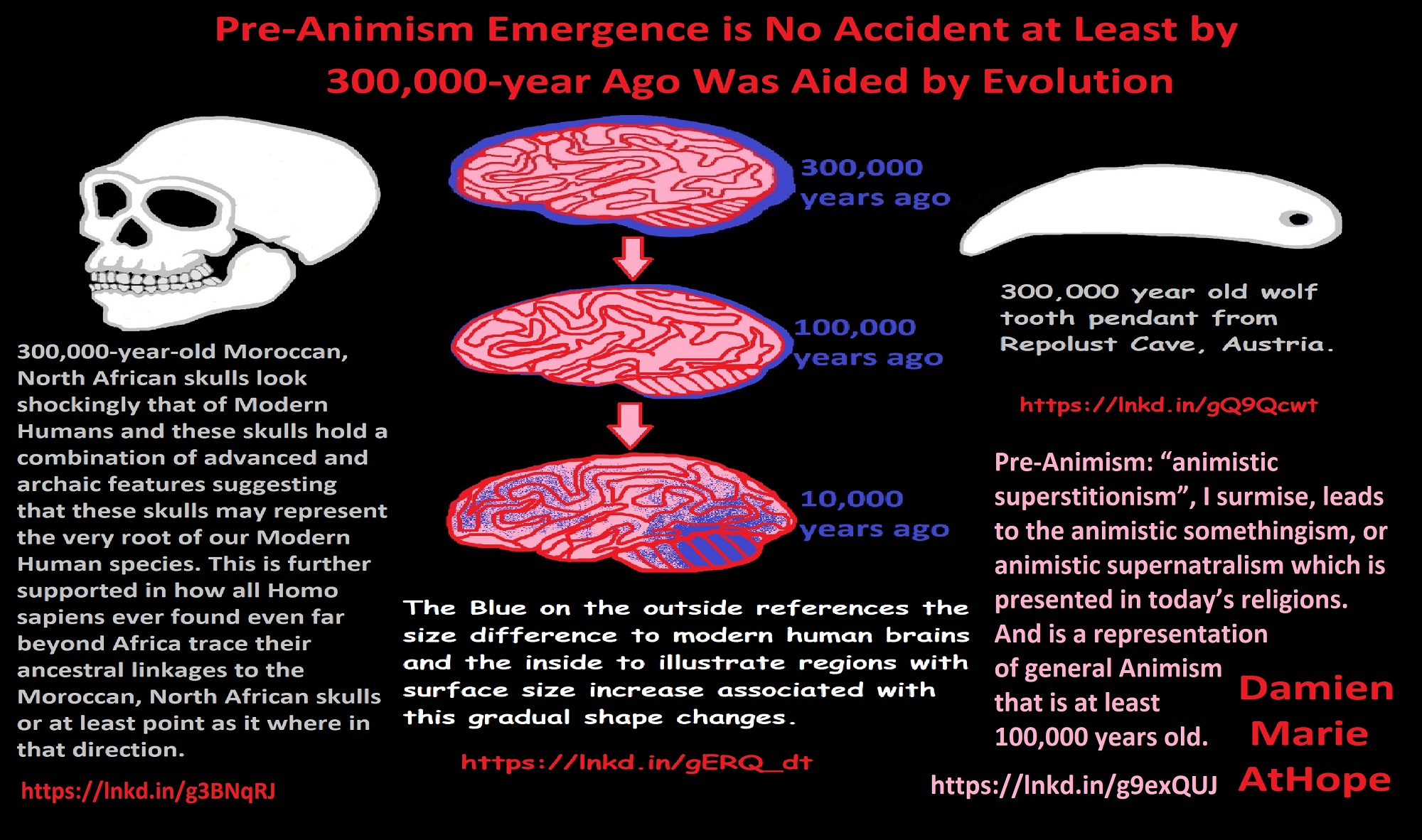
Pre-Animism Emergence is No Accident at Least by 300,000-year Ago Was Aided by Evolution
Pre-Animism: “animistic superstitionism”, I surmise, leads to the animistic somethingism, or animistic supernatralism is presented in today’s religions and is a representation of general Animism that is at least 100,000 years old. ref
The Blue on the outside references the size difference to modern human brains and the inside to illustrate regions with surface size increase associated with this gradual shape changes. ref
300,000-year-old Moroccan, North African skulls look shockingly that of Modern Humans and these skulls hold a combination of advanced and archaic features suggesting that these skulls may represent the very root of our Modern Human species. This is further supported in how all Homo sapiens ever found even far beyond Africa trace their ancestral linkages to the Moroccan, North African skulls or at least point as it where in that direction. And seemingly Homo sapiens could have been living across Africa and sem9ingly engaging in extensive movement, which could have involved exchange both in ideas, technology as well as even genetics. ref
300,000-year-old wolf tooth pendant from Repolust Cave, Austria. ref
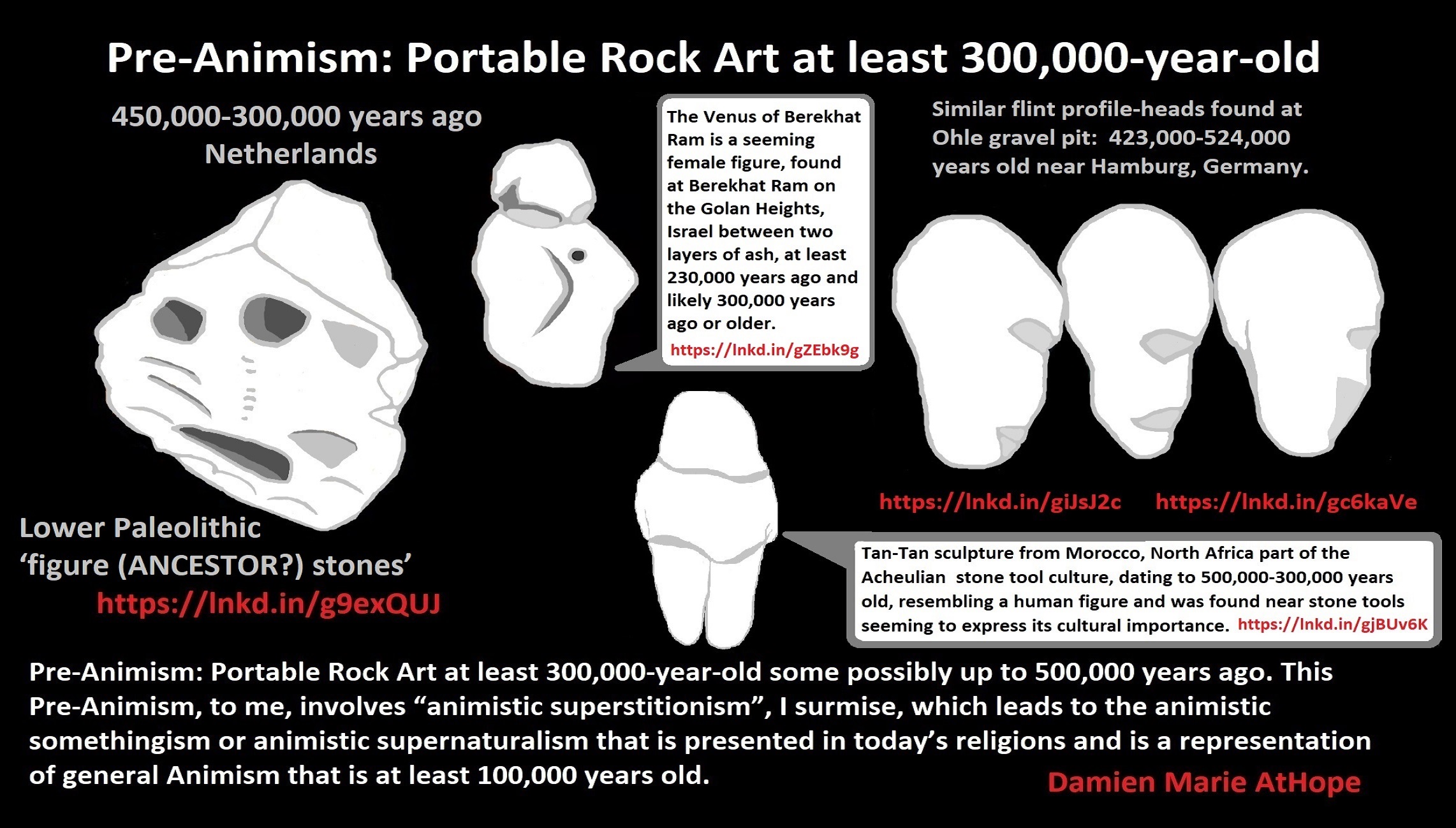
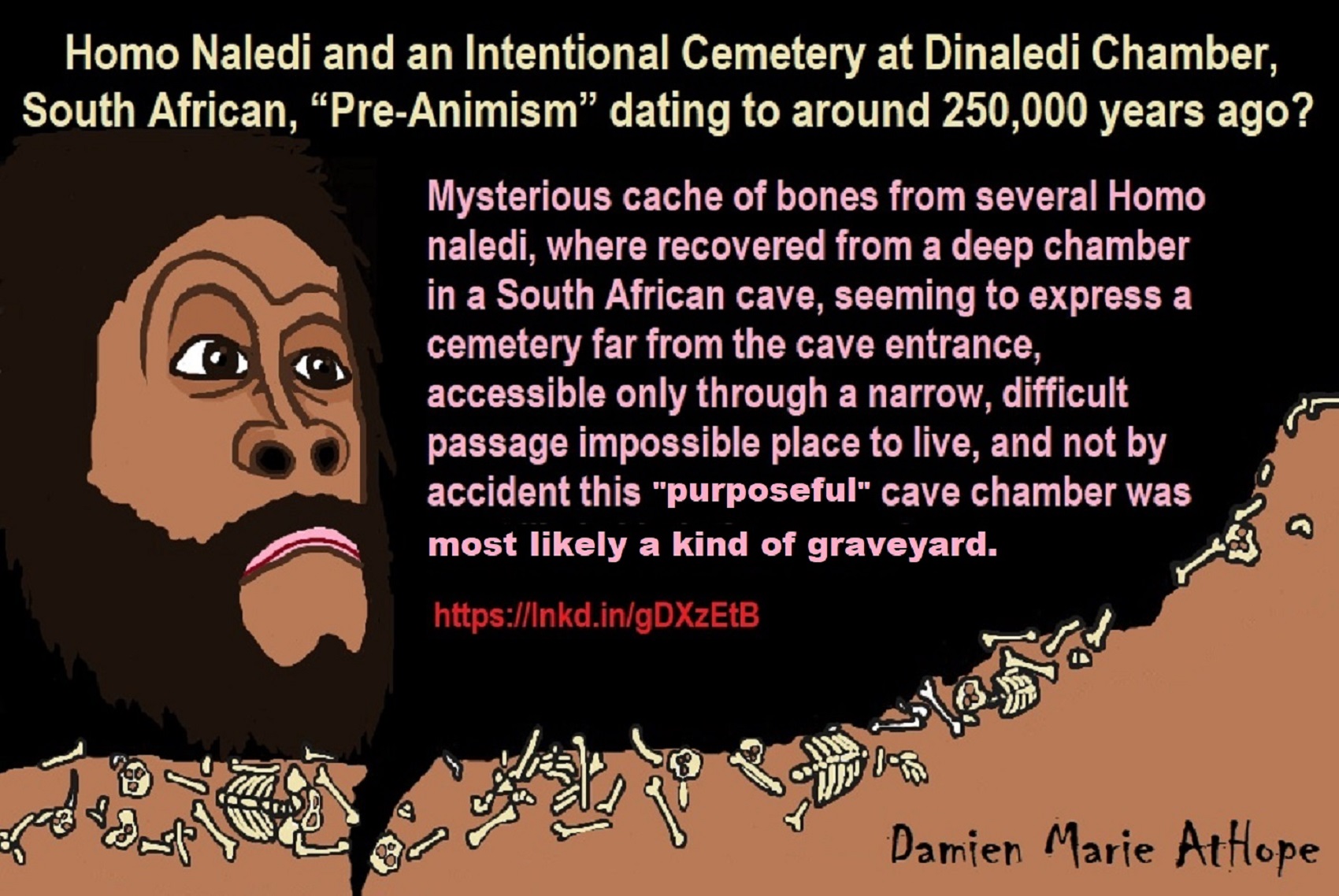
Homo Naledi and an Intentional Cemetery “Pre-Animism” dating to around 250,000 years ago?
To me, it seems likely Homo Naledi did have an intentional cemetery as seen at Dinaledi Chamber, in South Africa, thus “Pre-Animism” dating to around 250,000 years ago. The odd cache of bones from several Homo Naledi were recovered from a deep chamber in a South African cave, seeming to express a cemetery far from the cave entrance, accessible only through a narrow, difficult passage impossible place to live, and not by accident this purposeful cave chamber was most likely kind of graveyard. ref

Neanderthals “Primal Religion (Pre-Animism/Animism?)” Mystery Cave Rings 175,000 Years Ago
Neanderthals “Primal Religion (Pre-Animism/Animism?)”, Mystery Cave Rings 175,000 Years Ago, possibly a chapel or sacred space? Well, we do know it had meaning in some symbolic way, and they easily predate the arrival of modern humans in Europe. Thus, likely, they were built by Neanderthals, the only hominins in the region. The stalagmite structures are 50 centimeters high in places, says Jaubert. They are built from around 400 individual stalagmites with a combined weight of about 2 tons which must take time [to shift] and thus some time and effort to arrange the structures. ref

130,000 years ago – Earliest undisputed evidence for intentional burial and it is Neanderthals…
Evidence suggests that the Neanderthals were the first humans to intentionally bury the dead and possibly doing cannibalism which could be evidence of a death ritual, doing so in shallow graves along with stone tools and animal bones. 130,000 years ago – Earliest undisputed evidence for intentional burial. Neanderthals bury their dead at sites such as Krapina in Croatia. There was a total of 876 single Neanderthal fossil remnants found at the Hušnjak hill. The Bones belonged to several dozen different individuals, of different sex, from 2 to 40 years of age. Over a thousand pieces of various stone tools and weapons from the Paleolithic era were found, all witnessing to the material culture of the Krapina proto-human. This rich locality is approximately 130.000 years old.
Numerous fossil remnants of the cave bear, wolf, moose, large deer, warm climate rhinoceros, wild cattle and many other animals were also found. Moreover, there is bird skeletons, with some of the parts modified, are found in association with the Neanderthal bones. Here are some talons and foot bones from the white-tailed eagle. There appears to be cut marks in the talons and foot bones to which they were attached, suggesting that Neanderthals were using the talons and bones as jewelry. This is supported by recent findings of gut “fiber” tied around part of a talon. Here are a foot bone and a talon that have been modified by having grooves cut in them. Neanderthals were largely carnivores, though we know they also used medicinal plants. ref, ref, ref
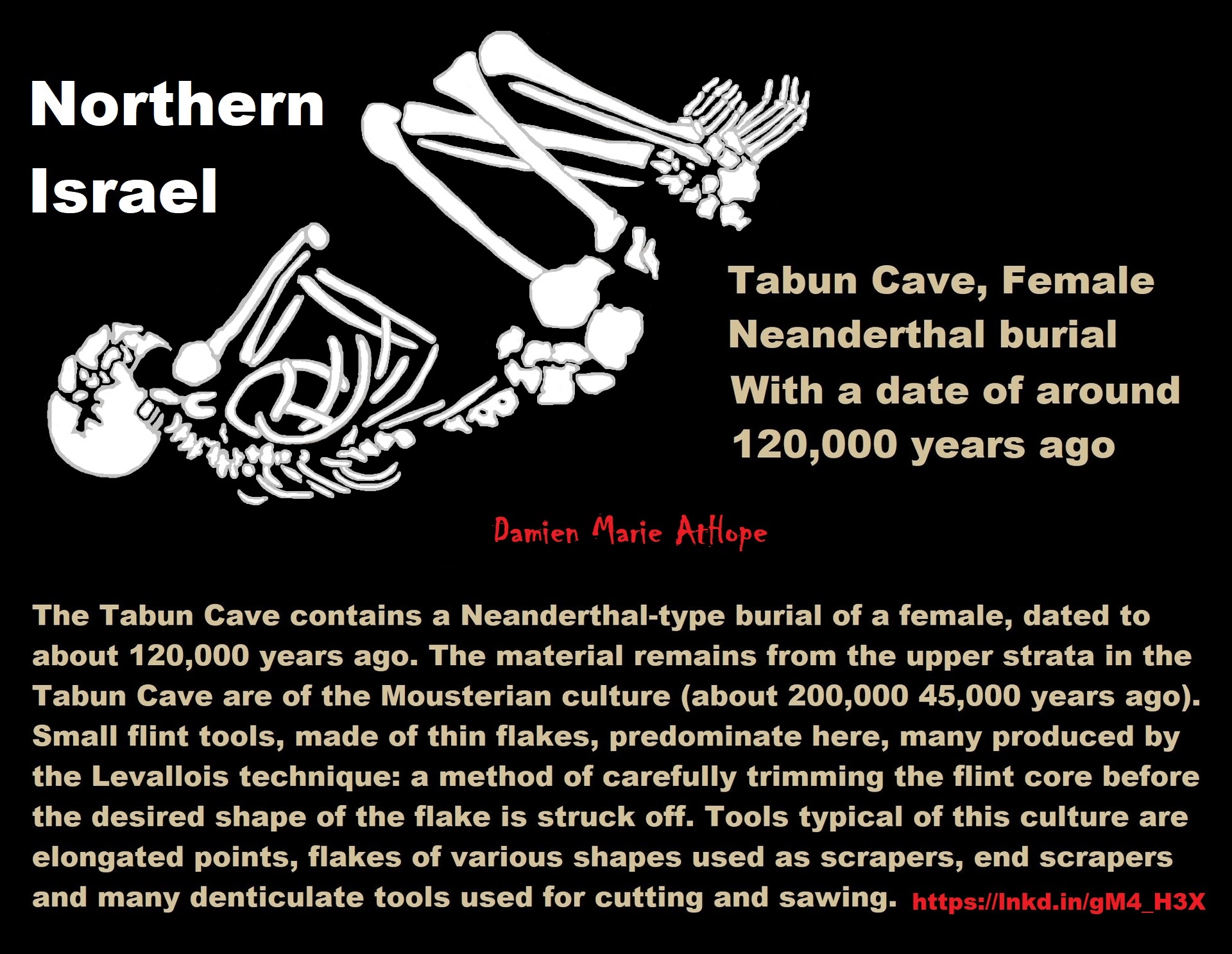
Did Neanderthals teach us “Primal Religion (Pre-Animism/Animism?)” 120,000 Years Ago?
Homo sapiens – is known to have reached the Levant between 120,000 and 90,000 years ago, but that exit from Africa evidently went extinct. Homo sapiens – is known to have reached the Levant between 120,000 and 90,000 years ago, but that exit from Africa evidently went extinct. Tabun Cave Mousterian (stone tool) culture (about 200,000 45,000 years ago). Small flint tools, made of thin flakes, predominate here, many produced by the Levallois technique. ref, ref

The Tabun Cave, Mount Carmel, Israel, occupied intermittently during the Lower and Middle Paleolithic (500,000 to around 40,000 years ago). Tabun suggests that ancestral humans used fire at the site on a regular basis since about 350,000 years ago and this likely would have shaped our culture and behavior. The material remains from the upper strata of the cave are of Levallois technique and the Mousterian culture (about 200,000 – 45,000 years ago). The Middle Palaeolithic of the southern Levant involved Neandertals and early modern humans, occupying the region at that time. Tabun Cave held fossil remains involved Neandertals and early modern humans but not an absolute chronology of the Levantine MP fossils though could indicates that an enamel fragment from the Tabun C1 could be as old as 143,000 years ago nearly double Tabun BC7. Moreover, a Neanderthal-type female, dated to about 120,000 years ago around the time early modern humans existed there which was between 120,000 – 90,000 years ago and again from 55,000 years ago on. ref, ref, ref, ref
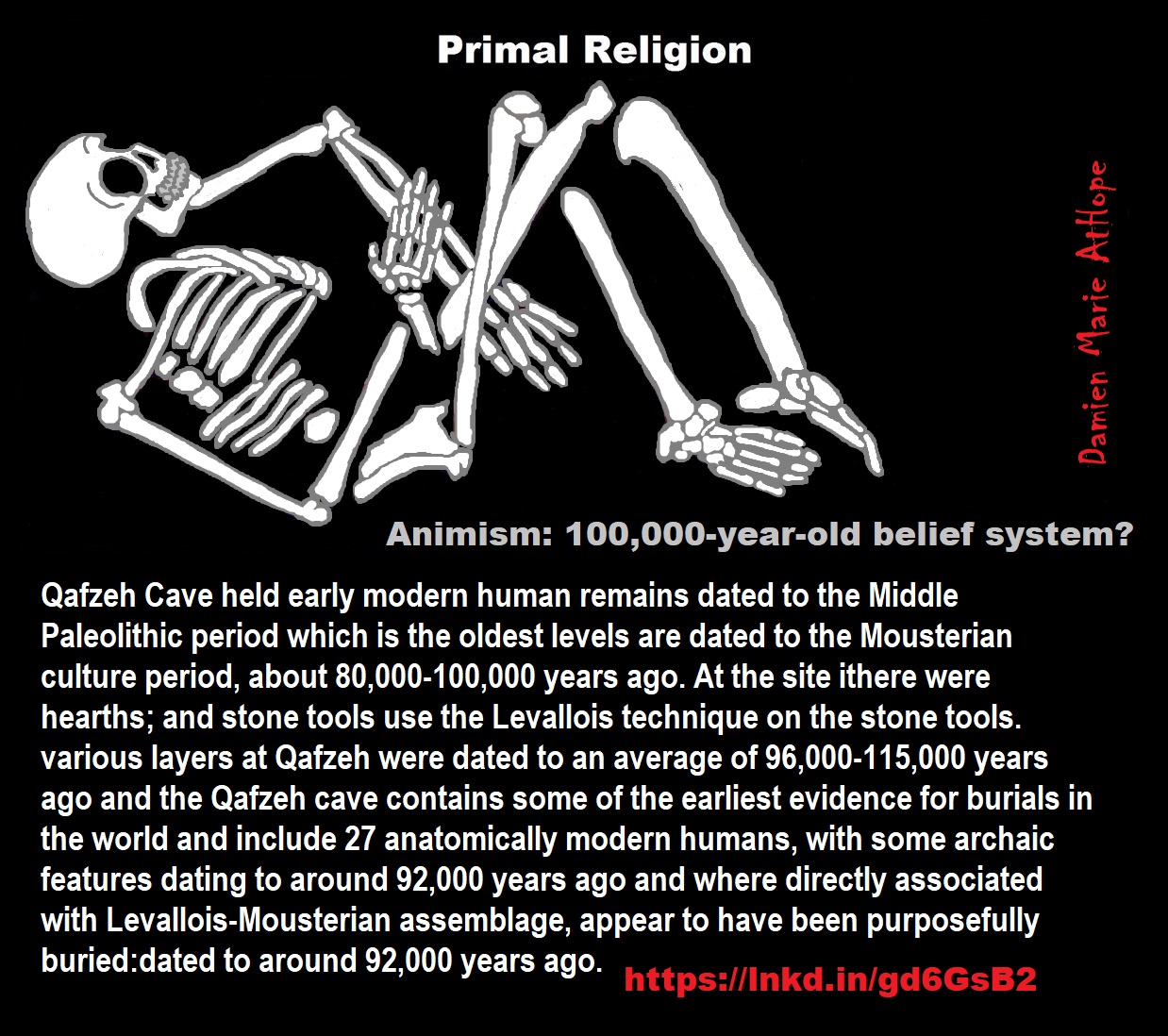
Animism: an approximately 100,000-year-old belief system?
Qafzeh Cave held early modern human remains dating to the Middle Paleolithic period which is the oldest levels are dated to the Mousterian culture period, about 80,000-100,000 years ago. At the site there were hearths; and stone tools use the Levallois technique on the stone tools. various layers at Qafzeh were dated to an average of 96,000-115,000 years ago and the Qafzeh cave contains some of the earliest evidence for burials in the world and included 27 anatomically modern humans, with some archaic features dating to around 92,000 years ago and were directly associated with Levallois-Mousterian assemblage, appear to have been purposefully buried: dated to around 92,000 years ago. The remains are from anatomically modern humans, with some archaic features; they are directly associated with Levallois-Mousterian assemblage. Modern behaviors indicated at the cave include the purposeful burials; the use of ochre for body painting; the presence of marine shells, used as ornamentation, and most interestingly, the survival and eventual ritual interment of a severely brain-damaged child. Moreover, deer antlers at Qafzeh 11 seem to be associated with burials unlike the marine shells which do not seem to be associated with burials, but rather are scattered more or less randomly throughout the site, possibly as a sacred offering, one that sanctifies an area? Or kind of blessing the aria? ref
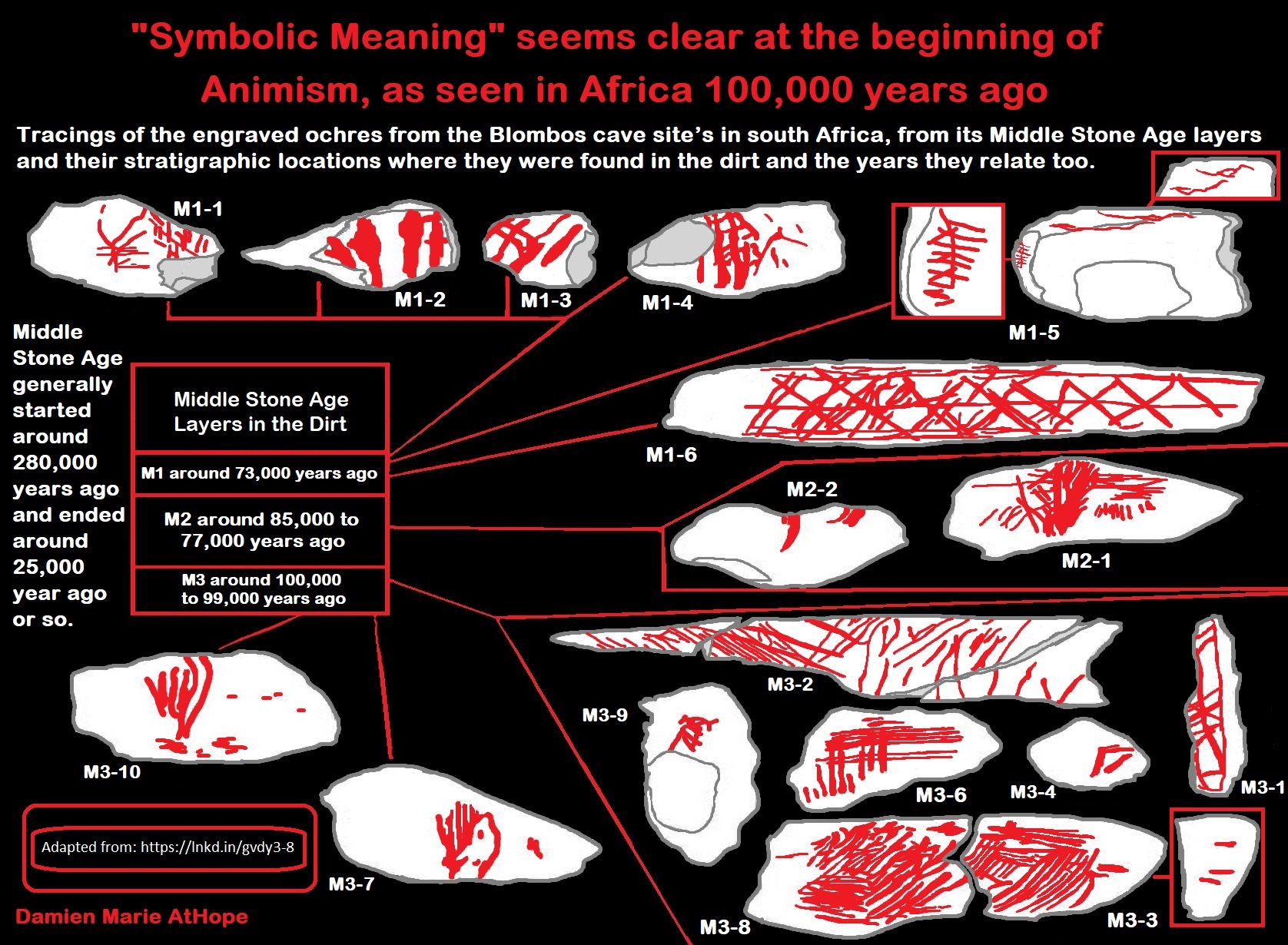
Adapted from: ref
Here we see the tracings of the engraved ochres from the Blombos cave site’s in South Africa, from its Middle Stone Age layers and their stratigraphic locations where they were found in the dirt and the years they relate to. M1 dates to around 73,000 years ago, M2 around 85,000 to 77,000 years ago, and M3 dates to around 100,000 to 99,000 years ago. Middle Stone Age generally started around 280,000 years ago and ended around 25,000 years ago or so. Therefore, amazing as it is, here we have proof that “Symbolic Meaning,” seems to be clear at the beginning of Animism, as seen in Africa 100,000 years ago. In a landmark study, it was demonstrated, for the first time, that there are seeming tradition in the production of geometric engraved representations, includes the production of a number of different patterns and this set of evolving traditions have roots that go back in time to at least 100,000 years ago (around a time I say Animism begins in Africa). The fact that they were created, that most of them are deliberate and were made with representational intent, strongly suggests they functioned as artifacts within a society by symbols with meaning. ref
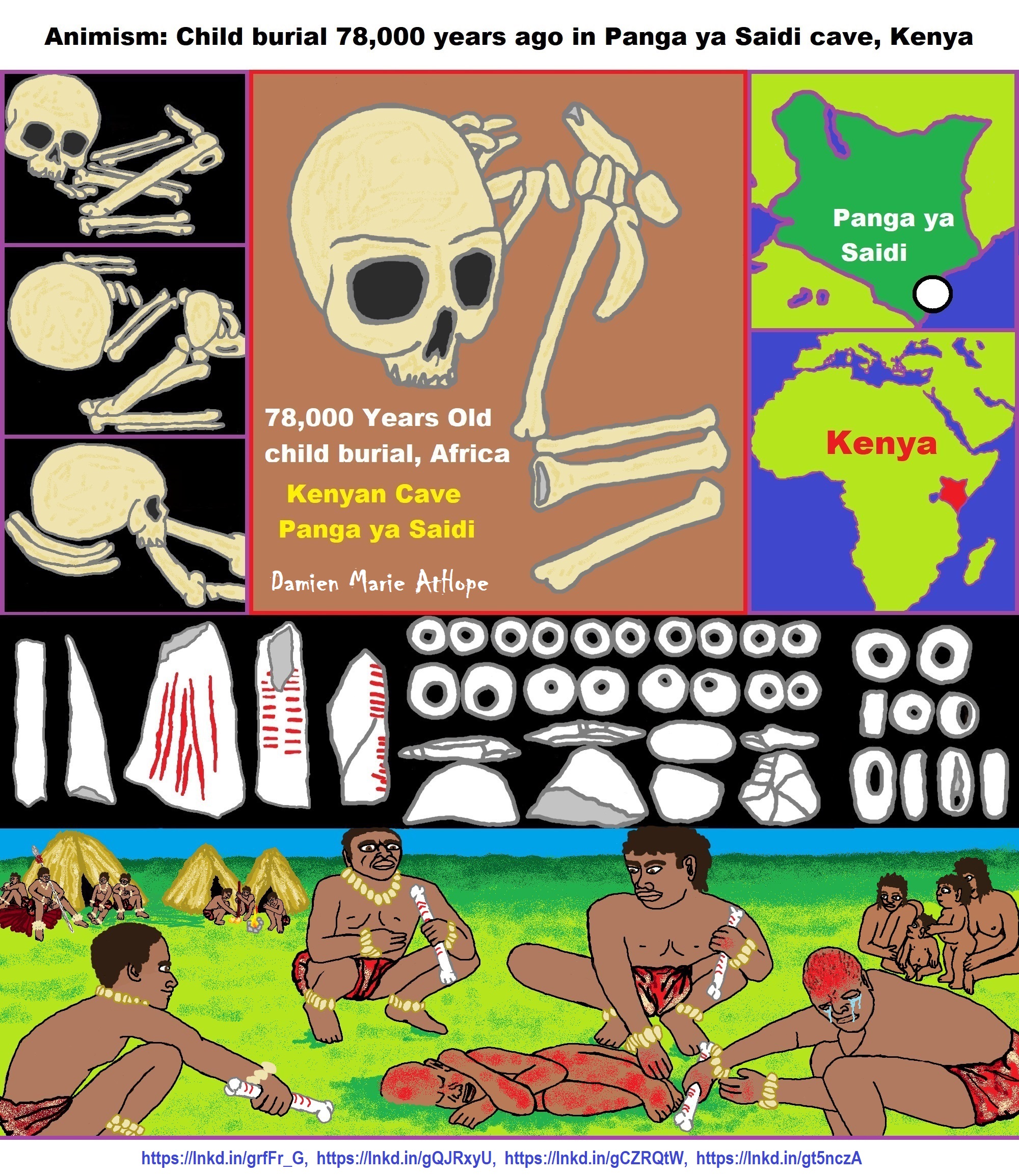
“Mtoto’s burial, to experts it is believed the child was around three years old when they died and was likely wrapped in a shroud and had their head on a pillow. Besides the seemingly deliberate position of the body, the team noticed a few clues that suggested the child was swaddled in cloth, possibly with the intention of preserving the corpse. They also speculate the body was placed in a cave fissure — known as funerary caching — before being covered with sediment.” ref, ref

At Border Cave, a “savanna-woodland” vegetation community is implied before 100,000 years ago and the matching density of stone tools vary considerably through time, with high frequencies of stone blades occurring before 100,000 years ago. ref
Around 74,000 years ago, in Border Cave, South Africa, the burial of a 4 to 6-month-old child was found in a pit with a personal ornament, a perforated Conus shell. ref
Border Cave is the only African site covering a time span of 250,000 years, with Middle Stone Age human remains, and also records the first emergence of key cultural innovations such as things like grass bedding dated between 70,000 to 30,000 years ago. ref
In South Africa, some of the oldest beads are made of marine shells that come from the Still Bay layers of Blombos Cave dating back to around 72,000 years ago, and engraved ostrich eggshells dated to around 60,000 years ago from Diepkloof in South Africa. Some of the oldest beads made of non-marine shells involve ostrich eggshells and from Border Cave, there are some that date to around 42,000 years ago. Beads were also collected from the late MSA/early LSA context of similar age at Apollo 11 and from layers associated with MSA at Boomplaas Cave. Furthermore, beads were also reported from the MSA at Cave of Hearths. Other sub-contemporaneous beads have been recovered north of South Africa. ref

Stone Snake of South Africa: “first human worship” 70,000 years ago
Evidence from Rhino Cave, in Botswana produced results that revealed a very special set of behavioral patterns which best-fit ritualized behavior. There were colorful non-local stone tools carefully and often elaborately made just to be offered to the stone snake; burned and smashed beyond use then abandoned. ref
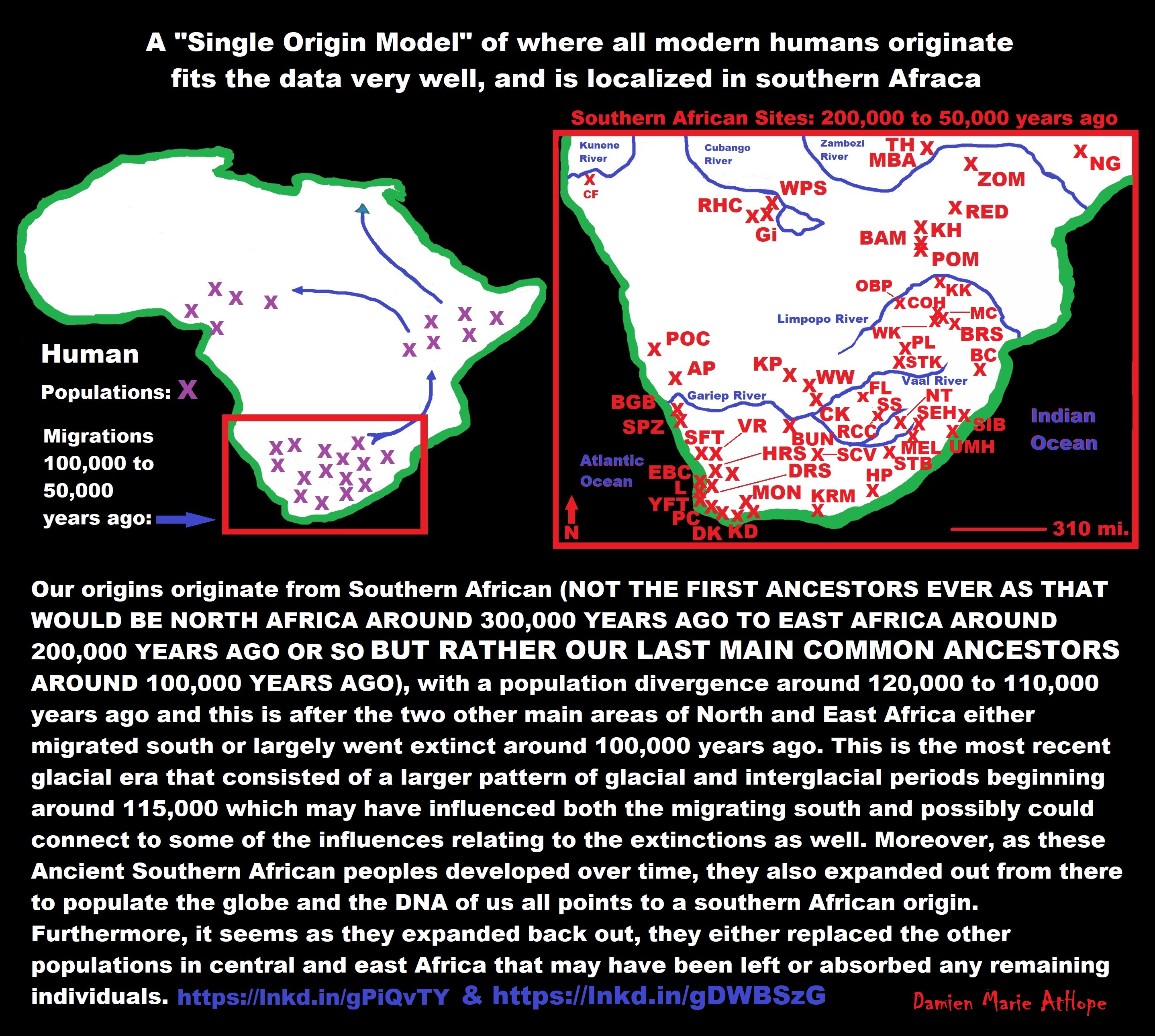
Our origins originate from Southern African (NOT THE FIRST ANCESTORS EVER AS THAT WOULD BE NORTH AFRICA AROUND 300,000 YEARS AGO TO EAST AFRICA AROUND 200,000 YEARS AGO OR SO BUT RATHER OUR LAST MAIN COMMON ANCESTORS AROUND 100,000 YEARS AGO), with a population divergence around 120,000 to 110,000 years ago and this is after the two other main areas of North and East Africa either migrated south or largely went extinct around 100,000 years ago. This is the most recent glacial era that consisted of a larger pattern of glacial and interglacial periods beginning around 115,000 which may have influenced both the migrating south and possibly could connect to some of the influences relating to the extinctions as well. Moreover, as these Ancient Southern African peoples developed over time, they also expanded out from there to populate the globe, and the DNA of us all points to a southern African origin. Furthermore, it seems as they expanded back out, they either replaced the other populations in central and east Africa that may have been left or absorbed any remaining individuals. ref
Southern African Middle Stone Age sites:
(Ap) Apollo 11; (BAM) Bambata; (BBC) Blombos Cave; (BC) Border Cave; (BGB)Boegoeberg; (BPA) Boomplaas; (BRS) Bushman Rock Shelter; (BUN) Bundu Farm; (CF)Cufema Reach; (CK) Canteen Kopje; (COH) Cave of Hearths; (CSB) Cape St Blaize; (DK)Die Kelders Cave 1; (DRS) Diepkloof Rock Shelter; (EBC) Elands Bay Cave; (FL) Florisbad; (≠GI) ≠Gi; (HP) Howiesons Poort; (HRS) Hollow Rock Shelter; (KD) Klipdrift; (KKH) Klein Kliphuis; (KH) Khami; (KK) Kudu Koppie; (KP) Kathu Pan; (KRM) Klasies River Main Site; (L) Langebaan; (MBA) Mumbwa Caves; (MC) Mwulu’s Cave; (MEL)Melikane; (MON) Montagu Cave; (NBC) Nelson Bay Cave; (NG) Ngalue; (NT) Ntloana Tšoana; (OBP) Olieboomspoort; (PC) Peers Cave; (POC) Pockenbank; (PL) Plover’s Lake; (POM) Pomongwe; (PP) Pinnacle Point; (RCC) Rose Cottage Cave; (RED) Redcliff; (RHC) Rhino Cave; (SCV) Seacow Valley; (SFT) Soutfontein; (SEH) Sehonghong; (SIB)Sibudu Cave; (SPZ) Spitzkloof Rock Shelter; (SS) Sunnyside 1; (STB) Strathalan Cave B; (STK) Sterkfontein; (TR) Twin Rivers; (UMH) Umhlatuzana; (VR) Varsche Rivier 003; (WPS) White Paintings Shelter; (WK) Wonderkrater; (WW) Wonderwerk; (YFT)Ysterfontein 1; (ZOM) Zombepata Cave. ref
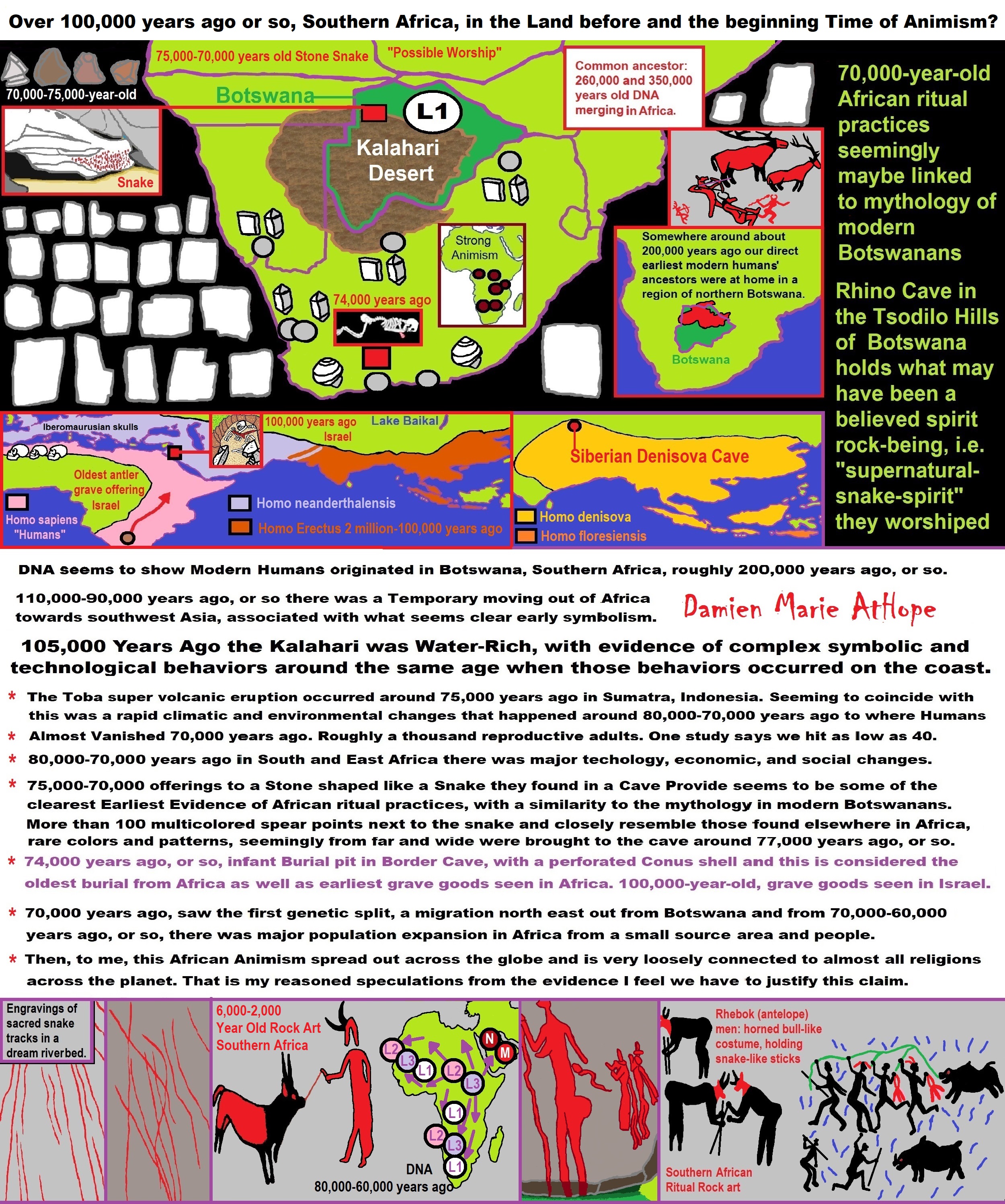
ref, ref, ref, ref, ref, ref, ref, ref, ref, ref, ref, ref, ref, ref, ref, ref, ref, ref, ref, ref, ref, ref, ref, ref, ref, ref, ref, ref, ref, ref, ref, ref, ref, ref, ref, ref, ref, ref, ref, ref, ref, ref, ref, ref, ref, ref, ref, ref, ref, ref, ref, ref
Animism: a belief among some indigenous people, young children, or all religious people!
Over 100,000 years ago or so, Southern Africa, in the Land before and the beginning Time of Animism: LINK

ref, ref, ref, ref, ref, ref, ref, ref, ref, ref, ref, ref, ref, ref, ref, ref, ref, ref, ref, ref, ref, ref, ref, ref, ref, ref, ref, ref, ref, ref, ref, ref, ref, ref, ref, ref, ref, ref, ref, ref, ref, ref, ref, ref, ref, ref, ref, ref, ref, ref, ref, ref, ref, ref, ref, ref, ref, ref, ref, ref,
Explaining the Earliest Religious Expression, that of Animism (beginning 100,000 to 70,000 years ago?) to Totemism (beginning 30,000 to 3,000 years ago?) in Southern Africa: LINK


It would seem that superstition was expanded and religion further imagined because both heavenly lights and flickering fire have been sacralized. Which does seem to be some what supported by a researcher who spent 40 years studding African Bushmen who gathered evidence of the importance of gathering around a nighttime campfire might be a universally applicable time for bonding, social information, many shared emotions, in fireside tales if we can ascertain a correlation that our prehistoric ancestors likely lived in a similar way to how the Bushmen current do. Although, we cannot directly peer into the past, or fully know the past from the indigenous Bushmen, these people do live in a way that our ancient ancestors lived for around 99% of our evolution.
Therefore, we can somewhat draw some reasonable parallels such as how daytime conversations focused mainly on social relationships with only a small percentage of stories, whereas the evening conversations around campfires centered on storytelling, especially the adding of stories about the spirit world adding possible credence to the thinking that nighttime and its darkness full of fear and or wonder in the flickering lights of fireside allows for more mystical thinking and the tales such an environment can produce which could have aided in socio-cultural-religious transformations or evolution.
The importance of water and fire can be a set of hidden factors to human evolution and socio-cultural-religious transformations and involved in many religion themes; lingering primitive animism still seen in current religions. Fire as sacred or magic can be seen in consuming fire, volcanos/lightning as gods power/vengeance, holy fire, fire as a means of transformation or magical purification or just a magical being itself as well as used in fire worship/worshiping the sun or punishment (hell: lake of fire which could be seen as mixing fire and water if only symbolically) used in ceremonies like bonfires, eternal flames, or sacred candles/incense/lights/lamps are in one form or another incorporated in many faiths such as judaism, christianity, islam, hinduism, buddhism, sikhism, bahaism, shintoism, taoism, etc.
All this worship of fire/sun are hardly special certain primates worship thunderstorms, others fire or sunrises. We have forgotten how nature worship, animistic superstitionism, or superstitionism is presented in today’s religion. The mega religions now think they are removed from animistic superstitionism, which they have not. Their rituals, beliefs, and prayers have a connection to animism nature worship but are more hidden or stylized, such as burning candles which is worshipping fire.
Wiessner, P. (2014). Did fireside tales aid social and cultural evolution?
Science Daily (2014). Firelight talk of the Kalahari Bushmen: Did tales told over fires aid our social and cultural evolution?
Science Daily (2014). Groundwater tied to human evolution.
Wikipedia (2015). Fire worship.
Daily Mail (2014). Sun-worshipping baboons rise early to catch the African sunrise – and race each other to the top for the best spots.
Shell ‘art’ made 300,000 years before humans evolved?
540,000 – 430,000 Years Ago – Trinil (Indonesia), found shells for tool production and evidence of an abstract engraving, one part looks like a pointed “M” or sharp teeth thought to have been made with a shark’s tooth, many of which were also found along with the worked shells.
40,000 Years Ago – Hohlenstein-Stadel cave (Germany), found evidence of a figurine labeled the Lion man, which is a lion-headed figurine made of mammoth ivory one of the oldest known zoomorphic (animal-shaped) and anthropomorphic (human-traits) sculpture in the world, and is associated with the archaeological titled Aurignacian culture. Also identified was a similar, but smaller, and more crude or warn lion-headed human sculpture dated to around 32,000 to 30,000 years ago, along with other animal figurines found in another cave in the same region of Germany. This leads to the possibility that such figurines may in some way have played an important role in the symbolism or mythology of early humans or may have been seen as a spirit helper or amulet that gave power or safety or the like. I think the belief in spirits came long before the idea of goddesses or gods. Following these discoveries, female figurines from approximately the same prehistoric period, such as the Venus of Hohle Fels, where discovered in the same mountainous area of Germany.
36,000 – 32,000 Years Ago – Chauvet Cave (France), found evidence of cave art in last and deepest of the Chauvet Cave chambers, is the home of Venus and The Sorcerer (could be dubbed the lion, bull and the Venus sorceress instead), cave art drawn in black charcoal. The black pubic triangle of the venus is at eye level and seems to be the heart of the composition. The white vulva slit appears to have been done later with a pointed tool and is clearly indicated by a vertical line incised strongly enough to cut through both the black pigment and the yellow surface film of the rock and there is a bullhead right above it and the bull leg is the venus leg. The Venus is the earliest of the designs, whereas the feline on the left adding a left leg, the Sorcerer, and the multiple lines on the right, are all painted or engraved later. Stylistic studies showed that some engravings are superimposed on black paintings proving the paintings’ older origins. Perhaps the female representation relates directly to the corridor to the chamber, which opens just behind her. Four other female representations limited to just the pubic triangle are in the cave. There are red handprints and red dots made into figures, red paint (ground red ocher) would be blown, probably by mouth, around the stencil of the artist’s hand. The paintings were created by people in the Aurignacian era or culture which involved sophisticated technology as well as art and self-awareness demonstrated in the work led archaeologists to consider the makers of Aurignacian artifacts the first modern humans in Europe.
Dolni Vestonice and the Three Sisters?
Dolni Vestonice and Pavlov burials, including the triple burial?
222 buried cities lost tribes?
27,000 – 23,000 Years Ago – Dolni Vestonice (Czech Republic), found a triple ritual burial that contains two males posed to either side of a female who had a pelvic deformity so could not have had children. The bodies were of three teenagers, one of the males had his hand between the female’s legs, where there is a stone too. Moreover, red ochre was placed between the female’s legs as well as on the heads of all three people. The other male lay on his stomach facing away from female but holding hand with a mask which depicts the woman. Also found was a single burial of women covered in red ochre along with two mammoth bones on top of her and there is a clay carving of her next to her. Women seems to hold some possible specialness and women of Ice Age Europe were not mere cave wives but shamanistic leaders, clever inventors, and mighty hunters. Furthermore, this site has one of the earliest known potter’s kiln as well as 2300 clay figurines; venus figurines, animals, and some weapons, evidence of trade, and a hollowed bone for flute. Specifically, there is a female figurine called the black venus of Dolni Vestonice a reddish clay figurine. Goddesses are usually inferred from depictions of females, whether sculpted or painted. However, I don’t believe all female figurines are goddesses I think it more likely they are ancestor totems or some other spirit. Moreover, I don’t believe it is right to brand all female figurines as earth mothers, fertility goddesses, but some may have been earth mothers, fertility goddesses, we just don’t. Although what we do know is while the rituals may differ by gender, or may be separate by gender in many cultures, the ability to reach the spirits is often perceived as essentially female and the female gender may have been attributed to the first supernatural entities. However, there also is also a carved ivory figure of young man which may represent the first example of portraiture dated to around 29,000 years ago.
27,000 – 19,000 Years Ago – Sungir (Russia), found evidence of modern human ritual graves consisting of an adult male in a single grave and a duel grave with a girl and a boy all buried wearing very heavily beaded clothing and grave goods. The male was around 50-65 years of age covered in red ochre buried in an extended position with this hands folded over his groin. He also had a beaded cap with some fox teeth, along with mammoth ivory bracelets some showing red and black paint and several thousand mammoth ivory beads. Moreover, a female skull had been placed beside a stone slab in an area stained with red ochre, and was found overlying the old man’s burial. The double burial is of a boy, 12-14 years old and a girl, 9-10 years old, buried head to head in a long, narrow grave, covered with red ochre, and ornamented with grave goods. Artifacts with the burials include several thousand mammoth ivory beads, hundreds of perforated arctic fox teeth, ivory pins, disc-shaped pendants, and ivory in geometric and animal carvings. Such as a small horse pendant next to the boy’s shoulder. He also had a beaded cap with some fox teeth and a decorated belt of polar fox teeth and an ivory pin at his throat. On his chest was a carved ivory pendant in the form of an animal. A long spear of straightened mammoth ivory almost 8 feet long on one side as well other smaller ones where placed alongside the double child’s burial. The girl also wore a beaded cap and an ivory pin at her throat, but her burial contains no fox teeth though at her side where two pierced antler batons, one of them decorated with rows of drilled dots. Moreover, a headless skeleton was found immediately on top of the two adolescents. Overall, there is an extraordinary mastering of technology expressed in quite a wide range of techniques cutting, sawing, planing/scraping were used to create collections of bones, antler and ivory artifacts. Furthermore, it seems ivory tools were only used as hunting, art or ornament objects and that such things were also found in the burials may have a symbolic meaning. Lastly, two human skeletons outside the settlement area without cultural remains. Ref Ref Ref Ref
20,000 – 14,000 Years Ago – Placard cave (France), found cave and portable art as well as stone tools and objects. The drawings are engravings of horses, deer, ibex, chamois, a saga of cattle, aurochs and a two buffalo heads sticking his tongue as well as a dozen signs in a “bird-shaped some of the art is painted red such as a man wounded by several spears illustrated in red ochre. There are several hundred carved stones, one coated with red ocher and other bone art and tools one engraved and carved ibex head on a baton, an engraved blade with a vulva carved in the handle and another object carved in the form of a handle with sharp ends. Also, found was wall art in red ochre of bird-like shape flying next to a dead or dying murdered man and wounded by several slashes or spears. The art found seems identical to those found in the caves of Pech Merle dating from 27,000 – 18,000 years ago and Cougnac cave dating from 27,000 – 14,000 years ago suggests a cultural group and such signs were also found in the Cosquer Cave. Ref
Insoll, T. (2012). The Oxford handbook of the archaeology of ritual and religion. Oxford, United Kingdom. Oxford University Press.
Hodder, I. (2013). Religion at Work in a Neolithic Society: Vital Matters. Cambridge University Press. Cambridge, United Kingdom. Kindle Edition.
Harris, S. L. (2007). Understanding the bible (7th Ed.). New York, NY: McGraw-Hill.
***Bible Creation Timeline Begins***
(This is the thinking of young earth creationism)
5,774 Years Ago – According to rabbinic tradition and based upon pertinent calculations that rely upon scriptural data as well as the start of the traditional jewish (or Hebrew) calendar year 5774 A.M. (“A.M.” here is short for Anno Mundi, which is Latin for “in the year of the world”). Finally, the bible allows us to have a “start date” the presumed time of all creation and no time before. Where did a young-earth worldview come from that contradicts the current scientific understanding that the earth is 4.55 billion years old? Simply put, it came from the bible. Of course, the bible does not say explicitly anywhere the earth is 5,774 or even 6,000 years old as it is usually stated in young earth creationism. So what is their argument in Genesis 1 that says the earth was created on the first day of creation. From there, young earth creationists calculate the age of the earth’s creation by calculating bible genealogies from Adam to Abraham in Genesis 5 and 11, then adding in the time from Abraham to our current time. If we add up the dates from Adam to Abraham, we get about 2,000 years, whether christian or secular, most scholars would agree that Abraham claimed to have lived about 4,000 years ago. Therefore, a simple calculation is: 2,000 years + 4,000 years = 6,000 years old young earth creationism thinking for the age of the earth.
5,600 Years Ago – (Egypt), Hierakonpolis (Nekhen), “City of the Falcon,” found a tomb and mummy of a male along with several small items most notably a crude ivory figurine of a thin bearded man possibly a god or an ancestor. 5,100 years ago, this old tomb was built before the rule of Narmer/Menes, the founder of the First Pharaonic Dynasty who unified Lower Egypt (northern) and Upper Egypt (southern). There are two temple sites associated with the ancient city of Hierakonpolis: 5,400 – 5,200 years ago, the pre-dynastic structures that were initially built of wood and reed matting were replaced with mud brick and sits in a pre-dynastic settlement near the desert to the west of the main settlement of Nekhen. The second and later temple was built within the town stonewalls of the city of Nekhen consisting of a large mound of clean sand supported by limestone blocks on which there may have been an Early Dynasty shrine containing several artifacts. The Narmer Palette is one of the items found and is a famous artifact of ancient Egypt. Likewise, a variety of ivory carvings with some inscribed with the names of Narmer. Also, found in Hierakonpolis, were the tombs of King Narmer and King Ka/Sekhen, a pre-dynastic pharaoh who paved the way to Egypt’s unification. King Narmer and King Ka expanded Egyptian power which is evident in the activity found in southern Canaan by the discovery of 33 serekhs on pottery shards at sites in Canaan dating 3,200 – 3,000 years ago proto-dynastic to First Dynasty. Thirteen of these belong to Narmer from six sites: Tel Arad (central Israel), Ein HaBesor (southern Israel), Tel es-Sakan (Gaza region of Israel), Nahal Tillah, Tel Erani, and Lod. An additional serekh from Lod is attributed to Narmer’s probable predecessor, Ka. The Ka hieroglyph holds the serekh with the horus name of the king, while the Ka itself holds an ostrich feather, the symbol of world order or ma’at, in one hand, and a long staff with a finial shaped like the king’s head in the other hand. Hence, the royal ka is related to the horus name describing the presence of that god in the king. This shows the dual nature of the king, which combines divine and mortal components. Also at Hierakonpolis, a sanctuary temple was composed of five small chambers likely not until the Middle Kingdom 4,134 – 3,991 years ago. A golden statue of nekheny meaning “falcon” (the falcon god who was assimilated by or was an early form of horus) was found buried in the floor of the central chamber. Ref Ref Ref
The Beginning Rise of the Unequal State Government Hierarchies, Religions and Cultures Merger
Among the earliest civilizations that exhibit the phenomenon of divinized kings are early Mesopotamia and ancient Egypt. In 5,150 BCE the First Dynasty appeared in Egypt with the unification of Upper and Lower Egypt by the king Menes (now believed to be Narmer). Menes/Narmer is depicted on inscriptions wearing the two crowns of Egypt, signifying unification, and his reign was thought to be in accordance with the will of the gods; but the office of the king itself was not associated with the divine until later. During the Second Dynasty of Egypt 4,890-4,670 years ago King Raneb (also known as Nebra) linked his name with the divine and his reign with the will of the gods. Following Raneb, the rulers of the later dynasties were equated with the gods and with the duties and obligations due those gods. As supreme ruler of the people, the pharaoh was considered a god on earth. The honorific title of `pharaoh’ for a ruler did not appear until the period known as the New Kingdom 3,570-3,069 years ago. Monarchs of the dynasties before the title of `pharaoh’ from the New Kingdom were addressed as `your majesty’ by foreign dignitaries and members of the court and as `brother’ by foreign rulers; both practices would continue after the king of Egypt came to be known as a pharaoh. Ref Ref
Sexism in the Major World Religions
In human history, when did the religious subjugation of goddess and by extension all women occur? Around 6,000 years ago, it can be hypothesized that male gods hit the scene in full force and about 5,000 years ago, women started to lose more, and eventually all value. In Turkey, archaeologists found 4,000-year-old tablets that cite women’s rights. However, more progress sexism continued to develop after 4,000 years ago. Even today, women hardly have any value or even regained a fully equal status.. The devaluing, disrespecting, and degrading of women came before societies developed the more fixed class/sex structures as we think of today.
Around 2,000 years ago, the manmade god concept took time to develop and finalized completely as the only or main gender of gods. It can be said that one of the male god concept’s goal was for male control and domination of female sexuality and their reproductive potential. Once the male god is established and by extension men with the promotion of patriarchy, it was relatively easy to maintain and enforce through holy books and laws written by men which established women’s lower status that deny women of education, their rights to their bodies, and exclude them from decision-making. Eventually, male dominance and its sexism were establish in nearly every known human society and has lasted for a few millennia. All religions have or are prone and promote sexism, some more than others but it is a shame they all share. Although though there is much more that can be said, I will only offer a few things as evidence of sexism in each of the current major world religions:
Sexism in Judaism (Old Testament):
Exodus 21:7 God not only sanctions selling ones daughter into slavery, but he also gives out laws on how it should be done.
Leviticus 27:3-7 God places a dollar value on human life; with women worth less than men.
Deuteronomy 22:23-24 women who are raped and fail to “cry out” likely enjoyed the attack thus should be killed.
Sexism in Christianity (New Testament):
1 Corinthians 11:7 – 9 “For a man is the image and glory of God: but the woman is the glory of the man. For the man is not of the woman; but the woman of the man.
Romans 7:2 “For the woman who hath a husband is bound by the law to her husband as long as he lives.
Titus 2:4-9 “Train the young women to be submissive to their husbands.
Sexism in Islam:
Qur’an (4:11) – (Inheritance) The male shall have the equal of the portion of two females (see also verse 4:176).
Qur’an (4:24) and Qur’an (33:50) – A man is permitted to take women as sex slaves outside of marriage.
Qur’an (4:34) – Men are in charge of women and good women are the obedient, because Allah hath made the one of them to excel the other.
Sexism in Hinduism:
Manusmriti 5.148. In childhood a female must be subject to her father, in youth to her husband, when her lord is dead to her sons; a woman must never be independent.
Manusmrti (9:2-4) – Men must make their women dependent day and night, and keep under their own control those who are attached to sensory objects. A woman is not fit for independence.
Rig Veda (8.33.33-34) – The mind of woman cannot be disciplined; she has very little intelligence.
Sexism in Buddhism:
Historical Buddha said the female’s defects greed, hate, delusion, and other defilements are greater than the male’s.
Historical Buddha who refused to ordain women as nuns. He said that allowing women into the sangha would cause his teachings to survive only half as long.
A popular belief in Buddhist countries is that negative karma results in a man being reborn as a woman and in Sukhavati-vyuha Sutra (Pure Land Buddhism) women must be reborn as men before they can enter Nirvana. Theravadan Buddhists claim a woman could never become a Buddha. The Ecclesiastical Buddhist Council of Thailand, announced publicly that any monk who supports the ordination of women will be subject to severe punishment.
Sexism in Shintoism:
The Kanamara Matsuri (“Festival of the Phallus”) is a Shinto celebration centred on a local penis-venerating shrine in Kawasaki, Japan. The legend being that a sharp-toothed demon (vagina dentata) hid inside the vagina of a young woman and castrated two young men on their wedding nights. As a result, the young woman sought help from a blacksmith, who fashioned an iron phallus to break the demon’s teeth, which led to the enshrinement of penis-venerating.
A spiritual practice specific to women involves a relationship to sight because they are always blind or visually impaired. Male sight, specifically women out of the public eye, occupies a privileged position in everything from ancient myths to the modern wedding ritual and continually exerts an oppressive influence on the lives of women, monitoring and impeding their public movements.
“Feminine Pollution” involves the idea in Shinto ritual, which has been used in the past to justify discrimination against women. Therefore, women have historically been pushed out of the public eye and out of public religious spaces because of their supposed impurity and to this day women are haunted by the belief in their inherent pollution.
Sexism in Sikhism:
The Gurus’ teaching on the role of women is stated as, “we are conceived and born from women. Woman is our life-long friend and keeps the race going. Why should we despise her, the one who gives birth to great men?” – Guru Granth Sahib Ji (the third Guru). Well, that still is saying its men that are great because of whom they are and women great only because they can produce great men still sounds like sexism to me.
Only Men as Guru only Men as the five Panj Pyare yes try to tell me of how Sikhism is completely equal to women…
Shiha Kaur a self-clamed feminist Sikh states,“ ancient cultural traditions sometimes take precedence over the principles of in Sikhism. Maharaja Ranjeet Singh, one of the most famous Sikh Kings in Moghul India often considered a model Sikh, had seven wives. Not only does polygamy go against Sikh beliefs but also half of his wives committed sati (widowed woman commits suicide by fire) when he died in 1839. In India today, school attendance of Sikh girls is lower than that of Sikh boys. The Asian Network has reported in the rise of Asian couples travelling to India to abort female fetuses and no sweets are shared among Sikh relatives to celebrate the birth of a girl, as usually happens when a boy is born.”
Sexism in Jainism:
Jainism does not teach that women can gain ultimate spiritual liberation, though a woman could strive to become a man in her next life so she could then reach enlightenment.
Jains believe, for example, that even microbes in the air and water are sacred life and any action that impacts other living things – such as driving or using electricity – can add to bad karma. Therefore, to Jains the bleeding which occurs in menstruation is thought to kill micro-organisms in the body, making the female body less nonviolent than the male body and the female body more prone to bad karma.
Digambara texts like Yuktiprabodha say that women’s genitals and breasts are sources of impurity and have many micro-organisms living in them. Digambara Jain theologians have written that due to bodily secretions, women suffer from itching which gives them uncontrollable sexual urges. They believe that women cannot take higher vows of ascetic renunciation, because naked women would have two deep emotions: shame of being naked and fear of sexual assault which they might face.
Sexism in Confucianism:
Confucius about women is “Shaoren and girls are difficult to handle. If you get familiar with them they cease to be humble. If you keep them away, they get resentful.” (Analects 17:25) This sure sounds insulting to women.
A well-known sexist Confucianism commandments is “Since the age of seven, men and women should not share a room or food” and “When young, a woman should obey the father, when married, the husband, when old, the son” are creations of later generation of Confucian scholars who developed a greater sexist tendency since the Tang dynasty era (618-907 C.E.).
According to the Confucian structure of society, women at every level were to occupy a position lower than men. Most Confucians accepted the subservience of women to men as natural and proper.
Sexism in Bahaism:
Highest leadership of the religion where only men Central figures: Bahá’u’lláh The Báb `Abdu’l-Bahá aso all men.
Women are excluded from serving on the religion’s highest governing body, the Universal House of Justice, which is confined to men only is sexist and does constitute evidence of the Bahá’í Faith support of superiority of men over women.
In 1997, a Canadian fantasy writer was disenrolled, primarily for his outspokenness on email forums for women’s full inclusion in Baha’i administration. Furthermore, in the Baha’i Faith there are particular cases of assignment of different roles to women and men at the level of individual life, family, and society.
Authoritarian Truth Seekers and Anti-Authoritarian Truth Seekers?
I understand that there are truth seekers and non-truth seekers (because of disinterest, dogma “false sense of truth” and/or delusion). But I also realize there are two types of truth seekers: Authoritarian Truth Seekers and Anti-Authoritarian Truth Seekers. Authoritarian Truth Seekers: to me use an Authoritarian Personality to understand, analyze, confirm truth, and limit what is thought of as truth. Authoritarian personality is a state of mind or attitude that is characterized by belief in absolute obedience or submissive to authority and possibly even one’s own authority, as well as the administration of that belief through the oppression of one’s subordinates. It is an ideology which entails accepting authority or hierarchical organization in the conduct of intellectual or human relations that includes authoritative, strict, or oppressive personality in truth acquisition and adherence to values or beliefs that are perceived as endorsed by followed leadership, authority of holy books, authority of gods, authority of beliefs held by someone who is favored or idolized, and authority of one’s own beliefs. Anti-Authoritarian Truth Seekers: to me use an Anti-Authoritarian Personality to understand, analyze and confirm truth. Anti-Authoritarian personality is a state of mind or attitude that is characterized by a cognitive application of freethought known as “freethinking” and is a philosophical viewpoint that holds that opinions should be formed on the basis of logic, reason, and empiricism, rather than authority, tradition, or other dogmas. Anti-Authoritarian personality is an opposition to authoritarianism, favoring instead full equality and open thinking in the conduct of intellectual or human relations, including democratic, flexible, or accessible personality in truth acquisition and adherence to values or beliefs perceived as endorsed by critical thinking and right reason which entails opposing authority as the means of conformation in truth attainment. To me Anti-Authoritarian Truth Seekers are the only real seekers of truth. To value faith as a means to know reality or the truth or something, is a mental weakness of wanting one’s beliefs about reality to matter more than the actual reality. Faith in relation of truth is at best just wishful emotions over rational understanding. Ref Ref

Art by Damien Marie AtHope
The Tree of Lies and its Hidden Roots back cover writing:
Religions continuing in our modern world, full of science and facts, should be seen as little more than a set of irrational conspiracy theories of reality. Nothing more than a confused reality made up of unscientific echoes from man’s ancient past. Rational thinkers must ask themselves why continue to believe in religions’ stories. Religion myths which are nothing more than childlike stories and obsolete tales once used to explain how the world works, acting like magic was needed when it was always only nature. These childlike religious stories should not even be taken seriously, but sadly too often they are. Often without realizing it, we accumulate beliefs that we allow to negatively influence our lives. In order to bring about awareness, we need to be willing to alter skewed beliefs. Rational thinkers must examine the facts instead of blindly following beliefs or faith.
The door of reason opens not once but many times.
This book is a collection of researched information such as archaeology, history, linguistics, genetics, art, science, sociology, geography, psychology, philosophy, theology, biology, and zoology. It will make you question your beliefs with information, inquiries, and ideas to ponder and expand on. The two main goals are to expose the evolution of religion starting 100,000 years ago, and to offer challenges to remove the rationale of faith. It is like an intervention for belief in myths that have plagued humankind for way too long. We often think we know what truth is but nevertheless, this can be but a vantage point away from losing credibility, if we are not willing to follow valid and reliable reason and evidence. The door of reason opens not once but many times. Come on a journey to free thought where the war is against ignorance and the victor is a rational mind.
Superstition to Religion “The Tree of Lies and its Hidden Roots”
I Believe Archaeology, not Myths & Why Not, as the Religious Myths Already Violate Reason!
Archaeological, Scientific, & Philosophic evidence shows the god myth is man-made nonsense.
Understanding Religion Evolution: Animism, Totemism, Shamanism, Paganism & Progressed organized religion





ref, ref, ref, ref, ref, ref, ref, ref, ref, ref, ref, ref, ref, ref, ref, ref, ref, ref, ref, ref, ref
Low Gods “Earth” or Tutelary deity and High Gods “Sky” or Supreme deity
“An Earth goddess is a deification of the Earth. Earth goddesses are often associated with the “chthonic” deities of the underworld. Ki and Ninhursag are Mesopotamian earth goddesses. In Greek mythology, the Earth is personified as Gaia, corresponding to Roman Terra, Indic Prithvi/Bhūmi, etc. traced to an “Earth Mother” complementary to the “Sky Father” in Proto-Indo-European religion. Egyptian mythology exceptionally has a sky goddess and an Earth god.” ref
“A mother goddess is a goddess who represents or is a personification of nature, motherhood, fertility, creation, destruction or who embodies the bounty of the Earth. When equated with the Earth or the natural world, such goddesses are sometimes referred to as Mother Earth or as the Earth Mother. In some religious traditions or movements, Heavenly Mother (also referred to as Mother in Heaven or Sky Mother) is the wife or feminine counterpart of the Sky father or God the Father.” ref
“Any masculine sky god is often also king of the gods, taking the position of patriarch within a pantheon. Such king gods are collectively categorized as “sky father” deities, with a polarity between sky and earth often being expressed by pairing a “sky father” god with an “earth mother” goddess (pairings of a sky mother with an earth father are less frequent). A main sky goddess is often the queen of the gods and may be an air/sky goddess in her own right, though she usually has other functions as well with “sky” not being her main. In antiquity, several sky goddesses in ancient Egypt, Mesopotamia, and the Near East were called Queen of Heaven. Neopagans often apply it with impunity to sky goddesses from other regions who were never associated with the term historically. The sky often has important religious significance. Many religions, both polytheistic and monotheistic, have deities associated with the sky.” ref
“In comparative mythology, sky father is a term for a recurring concept in polytheistic religions of a sky god who is addressed as a “father”, often the father of a pantheon and is often either a reigning or former King of the Gods. The concept of “sky father” may also be taken to include Sun gods with similar characteristics, such as Ra. The concept is complementary to an “earth mother“. “Sky Father” is a direct translation of the Vedic Dyaus Pita, etymologically descended from the same Proto-Indo-European deity name as the Greek Zeûs Pater and Roman Jupiter and Germanic Týr, Tir or Tiwaz, all of which are reflexes of the same Proto-Indo-European deity’s name, *Dyēus Ph₂tḗr. While there are numerous parallels adduced from outside of Indo-European mythology, there are exceptions (e.g. In Egyptian mythology, Nut is the sky mother and Geb is the earth father).” ref
Tutelary deity
“A tutelary (also tutelar) is a deity or spirit who is a guardian, patron, or protector of a particular place, geographic feature, person, lineage, nation, culture, or occupation. The etymology of “tutelary” expresses the concept of safety and thus of guardianship. In late Greek and Roman religion, one type of tutelary deity, the genius, functions as the personal deity or daimon of an individual from birth to death. Another form of personal tutelary spirit is the familiar spirit of European folklore.” ref
“A tutelary (also tutelar) in Korean shamanism, jangseung and sotdae were placed at the edge of villages to frighten off demons. They were also worshiped as deities. Seonangshin is the patron deity of the village in Korean tradition and was believed to embody the Seonangdang. In Philippine animism, Diwata or Lambana are deities or spirits that inhabit sacred places like mountains and mounds and serve as guardians. Such as: Maria Makiling is the deity who guards Mt. Makiling and Maria Cacao and Maria Sinukuan. In Shinto, the spirits, or kami, which give life to human bodies come from nature and return to it after death. Ancestors are therefore themselves tutelaries to be worshiped. And similarly, Native American beliefs such as Tonás, tutelary animal spirit among the Zapotec and Totems, familial or clan spirits among the Ojibwe, can be animals.” ref
“A tutelary (also tutelar) in Austronesian beliefs such as: Atua (gods and spirits of the Polynesian peoples such as the Māori or the Hawaiians), Hanitu (Bunun of Taiwan‘s term for spirit), Hyang (Kawi, Sundanese, Javanese, and Balinese Supreme Being, in ancient Java and Bali mythology and this spiritual entity, can be either divine or ancestral), Kaitiaki (New Zealand Māori term used for the concept of guardianship, for the sky, the sea, and the land), Kawas (mythology) (divided into 6 groups: gods, ancestors, souls of the living, spirits of living things, spirits of lifeless objects, and ghosts), Tiki (Māori mythology, Tiki is the first man created by either Tūmatauenga or Tāne and represents deified ancestors found in most Polynesian cultures). ” ref, ref, ref, ref, ref, ref, ref
Mesopotamian Tutelary Deities can be seen as ones related to City-States
“Historical city-states included Sumerian cities such as Uruk and Ur; Ancient Egyptian city-states, such as Thebes and Memphis; the Phoenician cities (such as Tyre and Sidon); the five Philistine city-states; the Berber city-states of the Garamantes; the city-states of ancient Greece (the poleis such as Athens, Sparta, Thebes, and Corinth); the Roman Republic (which grew from a city-state into a vast empire); the Italian city-states from the Middle Ages to the early modern period, such as Florence, Siena, Ferrara, Milan (which as they grew in power began to dominate neighboring cities) and Genoa and Venice, which became powerful thalassocracies; the Mayan and other cultures of pre-Columbian Mesoamerica (including cities such as Chichen Itza, Tikal, Copán and Monte Albán); the central Asian cities along the Silk Road; the city-states of the Swahili coast; Ragusa; states of the medieval Russian lands such as Novgorod and Pskov; and many others.” ref
“The Uruk period (ca. 4000 to 3100 BCE; also known as Protoliterate period) of Mesopotamia, named after the Sumerian city of Uruk, this period saw the emergence of urban life in Mesopotamia and the Sumerian civilization. City-States like Uruk and others had a patron tutelary City Deity along with a Priest-King.” ref
“Chinese folk religion, both past, and present, includes myriad tutelary deities. Exceptional individuals, highly cultivated sages, and prominent ancestors can be deified and honored after death. Lord Guan is the patron of military personnel and police, while Mazu is the patron of fishermen and sailors. Such as Tu Di Gong (Earth Deity) is the tutelary deity of a locality, and each individual locality has its own Earth Deity and Cheng Huang Gong (City God) is the guardian deity of an individual city, worshipped by local officials and locals since imperial times.” ref
“A tutelary (also tutelar) in Hinduism, personal tutelary deities are known as ishta-devata, while family tutelary deities are known as Kuladevata. Gramadevata are guardian deities of villages. Devas can also be seen as tutelary. Shiva is the patron of yogis and renunciants. City goddesses include: Mumbadevi (Mumbai), Sachchika (Osian); Kuladevis include: Ambika (Porwad), and Mahalakshmi. In NorthEast India Meitei mythology and religion (Sanamahism) of Manipur, there are various types of tutelary deities, among which Lam Lais are the most predominant ones. Tibetan Buddhism has Yidam as a tutelary deity. Dakini is the patron of those who seek knowledge.” ref
“A tutelary (also tutelar) The Greeks also thought deities guarded specific places: for instance, Athena was the patron goddess of the city of Athens. Socrates spoke of hearing the voice of his personal spirit or daimonion:
You have often heard me speak of an oracle or sign which comes to me … . This sign I have had ever since I was a child. The sign is a voice which comes to me and always forbids me to do something which I am going to do, but never commands me to do anything, and this is what stands in the way of my being a politician.” ref
“Tutelary deities who guard and preserve a place or a person are fundamental to ancient Roman religion. The tutelary deity of a man was his Genius, that of a woman her Juno. In the Imperial era, the Genius of the Emperor was a focus of Imperial cult. An emperor might also adopt a major deity as his personal patron or tutelary, as Augustus did Apollo. Precedents for claiming the personal protection of a deity were established in the Republican era, when for instance the Roman dictator Sulla advertised the goddess Victory as his tutelary by holding public games (ludi) in her honor.” ref
“Each town or city had one or more tutelary deities, whose protection was considered particularly vital in time of war and siege. Rome itself was protected by a goddess whose name was to be kept ritually secret on pain of death (for a supposed case, see Quintus Valerius Soranus). The Capitoline Triad of Juno, Jupiter, and Minerva were also tutelaries of Rome. The Italic towns had their own tutelary deities. Juno often had this function, as at the Latin town of Lanuvium and the Etruscan city of Veii, and was often housed in an especially grand temple on the arx (citadel) or other prominent or central location. The tutelary deity of Praeneste was Fortuna, whose oracle was renowned.” ref
“The Roman ritual of evocatio was premised on the belief that a town could be made vulnerable to military defeat if the power of its tutelary deity were diverted outside the city, perhaps by the offer of superior cult at Rome. The depiction of some goddesses such as the Magna Mater (Great Mother, or Cybele) as “tower-crowned” represents their capacity to preserve the city. A town in the provinces might adopt a deity from within the Roman religious sphere to serve as its guardian, or syncretize its own tutelary with such; for instance, a community within the civitas of the Remi in Gaul adopted Apollo as its tutelary, and at the capital of the Remi (present-day Rheims), the tutelary was Mars Camulus.” ref
Household deity (a kind of or related to a Tutelary deity)
“A household deity is a deity or spirit that protects the home, looking after the entire household or certain key members. It has been a common belief in paganism as well as in folklore across many parts of the world. Household deities fit into two types; firstly, a specific deity – typically a goddess – often referred to as a hearth goddess or domestic goddess who is associated with the home and hearth, such as the ancient Greek Hestia.” ref
“The second type of household deities are those that are not one singular deity, but a type, or species of animistic deity, who usually have lesser powers than major deities. This type was common in the religions of antiquity, such as the Lares of ancient Roman religion, the Gashin of Korean shamanism, and Cofgodas of Anglo-Saxon paganism. These survived Christianisation as fairy-like creatures existing in folklore, such as the Anglo-Scottish Brownie and Slavic Domovoy.” ref
“Household deities were usually worshipped not in temples but in the home, where they would be represented by small idols (such as the teraphim of the Bible, often translated as “household gods” in Genesis 31:19 for example), amulets, paintings, or reliefs. They could also be found on domestic objects, such as cosmetic articles in the case of Tawaret. The more prosperous houses might have a small shrine to the household god(s); the lararium served this purpose in the case of the Romans. The gods would be treated as members of the family and invited to join in meals, or be given offerings of food and drink.” ref
“In many religions, both ancient and modern, a god would preside over the home. Certain species, or types, of household deities, existed. An example of this was the Roman Lares. Many European cultures retained house spirits into the modern period. Some examples of these include:
- Brownie (Scotland and England) or Hob (England) / Kobold (Germany) / Goblin / Hobgoblin
- Domovoy (Slavic)
- Nisse (Norwegian or Danish) / Tomte (Swedish) / Tonttu (Finnish)
- Húsvættir (Norse)” ref
“Although the cosmic status of household deities was not as lofty as that of the Twelve Olympians or the Aesir, they were also jealous of their dignity and also had to be appeased with shrines and offerings, however humble. Because of their immediacy they had arguably more influence on the day-to-day affairs of men than the remote gods did. Vestiges of their worship persisted long after Christianity and other major religions extirpated nearly every trace of the major pagan pantheons. Elements of the practice can be seen even today, with Christian accretions, where statues to various saints (such as St. Francis) protect gardens and grottos. Even the gargoyles found on older churches, could be viewed as guardians partitioning a sacred space.” ref
“For centuries, Christianity fought a mop-up war against these lingering minor pagan deities, but they proved tenacious. For example, Martin Luther‘s Tischreden have numerous – quite serious – references to dealing with kobolds. Eventually, rationalism and the Industrial Revolution threatened to erase most of these minor deities, until the advent of romantic nationalism rehabilitated them and embellished them into objects of literary curiosity in the 19th century. Since the 20th century this literature has been mined for characters for role-playing games, video games, and other fantasy personae, not infrequently invested with invented traits and hierarchies somewhat different from their mythological and folkloric roots.” ref
“In contradistinction to both Herbert Spencer and Edward Burnett Tylor, who defended theories of animistic origins of ancestor worship, Émile Durkheim saw its origin in totemism. In reality, this distinction is somewhat academic, since totemism may be regarded as a particularized manifestation of animism, and something of a synthesis of the two positions was attempted by Sigmund Freud. In Freud’s Totem and Taboo, both totem and taboo are outward expressions or manifestations of the same psychological tendency, a concept which is complementary to, or which rather reconciles, the apparent conflict. Freud preferred to emphasize the psychoanalytic implications of the reification of metaphysical forces, but with particular emphasis on its familial nature. This emphasis underscores, rather than weakens, the ancestral component.” ref
“William Edward Hearn, a noted classicist, and jurist, traced the origin of domestic deities from the earliest stages as an expression of animism, a belief system thought to have existed also in the neolithic, and the forerunner of Indo-European religion. In his analysis of the Indo-European household, in Chapter II “The House Spirit”, Section 1, he states:
The belief which guided the conduct of our forefathers was … the spirit rule of dead ancestors.” ref
“In Section 2 he proceeds to elaborate:
It is thus certain that the worship of deceased ancestors is a vera causa, and not a mere hypothesis. …
In the other European nations, the Slavs, the Teutons, and the Kelts, the House Spirit appears with no less distinctness. … [T]he existence of that worship does not admit of doubt. … The House Spirits had a multitude of other names which it is needless here to enumerate, but all of which are more or less expressive of their friendly relations with man. … In [England] … [h]e is the Brownie. … In Scotland this same Brownie is well known. He is usually described as attached to particular families, with whom he has been known to reside for centuries, threshing the corn, cleaning the house, and performing similar household tasks. His favorite gratification was milk and honey.” ref

- Ancient Aliens Conspiracy Theorists are Pseudohistorians
- Yes, you need to know about Animism to understand Religion
- Animism, Totemism, Shamanism, and Paganism
- Religion Dispersal throughout the World
- Need for “Religion”?
- A Rational Mind Values Humanity and Rejects Religion and Gods
- Creationism (pseudoscience)
- Science Facts Should Make Religious Belief Impossible

My thoughts on Religion Evolution with external links for more info:
- (Pre-Animism Africa mainly, but also Europe, and Asia at least 300,000 years ago), (Pre-Animism – Oxford Dictionaries)
- (Animism Africa around 100,000 years ago), (Animism – Britannica.com)
- (Totemism Europe around 50,000 years ago), (Totemism – Anthropology)
- (Shamanism Siberia around 30,000 years ago), (Shamanism – Britannica.com)
- (Paganism Turkey around 12,000 years ago), (Paganism – BBC Religion)
- (Progressed Organized Religion “Institutional Religion” Egypt around 5,000 years ago), (Ancient Egyptian Religion – Britannica.com)
- (CURRENT “World” RELIGIONS after 4,000 years ago) (Origin of Major Religions – Sacred Texts)
- (Early Atheistic Doubting at least by 2,600 years ago) (History of Atheism – Wikipedia)
“Religion is an Evolved Product” and Yes, Religion is Like Fear Given Wings…
Atheists talk about gods and religions for the same reason doctors talk about cancer, they are looking for a cure, or a firefighter talks about fires because they burn people and they care to stop them. We atheists too often feel a need to help the victims of mental slavery, held in the bondage that is the false beliefs of gods and the conspiracy theories of reality found in religions.
Understanding Religion Evolution:
- Pre-Animism (at least 300,000 years ago)
- Animism (Africa: 100,000 years ago)
- Totemism (Europe: 50,000 years ago)
- Shamanism (Siberia: 30,000 years ago)
- Paganism (Turkey: 12,000 years ago)
- Progressed organized religion (Egypt: 5,000 years ago), (Egypt, the First Dynasty 5,150 years ago)
- CURRENT “World” RELIGIONS (after 4,000 years ago)
- Early Atheistic Doubting (at least by 2,600 years ago)
“An Archaeological/Anthropological Understanding of Religion Evolution”
It seems ancient peoples had to survived amazing threats in a “dangerous universe (by superstition perceived as good and evil),” and human “immorality or imperfection of the soul” which was thought to affect the still living, leading to ancestor worship. This ancestor worship presumably led to the belief in supernatural beings, and then some of these were turned into the belief in gods. This feeble myth called gods were just a human conceived “made from nothing into something over and over, changing, again and again, taking on more as they evolve, all the while they are thought to be special,” but it is just supernatural animistic spirit-belief perceived as sacred.
Quick Evolution of Religion?
Pre-Animism (at least 300,000 years ago) pre-religion is a beginning that evolves into later Animism. So, Religion as we think of it, to me, all starts in a general way with Animism (Africa: 100,000 years ago) (theoretical belief in supernatural powers/spirits), then this is physically expressed in or with Totemism (Europe: 50,000 years ago) (theoretical belief in mythical relationship with powers/spirits through a totem item), which then enlists a full-time specific person to do this worship and believed interacting Shamanism (Siberia/Russia: 30,000 years ago) (theoretical belief in access and influence with spirits through ritual), and then there is the further employment of myths and gods added to all the above giving you Paganism (Turkey: 12,000 years ago) (often a lot more nature-based than most current top world religions, thus hinting to their close link to more ancient religious thinking it stems from). My hypothesis is expressed with an explanation of the building of a theatrical house (modern religions development). Progressed organized religion (Egypt: 5,000 years ago) with CURRENT “World” RELIGIONS (after 4,000 years ago).
Historically, in large city-state societies (such as Egypt or Iraq) starting around 5,000 years ago culminated to make religion something kind of new, a sociocultural-governmental-religious monarchy, where all or at least many of the people of such large city-state societies seem familiar with and committed to the existence of “religion” as the integrated life identity package of control dynamics with a fixed closed magical doctrine, but this juggernaut integrated religion identity package of Dogmatic-Propaganda certainly did not exist or if developed to an extent it was highly limited in most smaller prehistoric societies as they seem to lack most of the strong control dynamics with a fixed closed magical doctrine (magical beliefs could be at times be added or removed). Many people just want to see developed religious dynamics everywhere even if it is not. Instead, all that is found is largely fragments until the domestication of religion.
Religions, as we think of them today, are a new fad, even if they go back to around 6,000 years in the timeline of human existence, this amounts to almost nothing when seen in the long slow evolution of religion at least around 70,000 years ago with one of the oldest ritual worship. Stone Snake of South Africa: “first human worship” 70,000 years ago. This message of how religion and gods among them are clearly a man-made thing that was developed slowly as it was invented and then implemented peace by peace discrediting them all. Which seems to be a simple point some are just not grasping how devastating to any claims of truth when we can see the lie clearly in the archeological sites.
I wish people fought as hard for the actual values as they fight for the group/clan names political or otherwise they think support values. Every amount spent on war is theft to children in need of food or the homeless kept from shelter.
Here are several of my blog posts on history:
- To Find Truth You Must First Look
- (Magdalenian/Iberomaurusian) Connections to the First Paganists of the early Neolithic Near East Dating from around 17,000 to 12,000 Years Ago
- Natufians: an Ancient People at the Origins of Agriculture and Sedentary Life
- Possible Clan Leader/Special “MALE” Ancestor Totem Poles At Least 13,500 years ago?
- Jewish People with DNA at least 13,200 years old, Judaism, and the Origins of Some of its Ideas
- Baltic Reindeer Hunters: Swiderian, Lyngby, Ahrensburgian, and Krasnosillya cultures 12,020 to 11,020 years ago are evidence of powerful migratory waves during the last 13,000 years and a genetic link to Saami and the Finno-Ugric peoples.
- The Rise of Inequality: patriarchy and state hierarchy inequality
- Fertile Crescent 12,500 – 9,500 Years Ago: fertility and death cult belief system?
- 12,400 – 11,700 Years Ago – Kortik Tepe (Turkey) Pre/early-Agriculture Cultic Ritualism
- Ritualistic Bird Symbolism at Gobekli Tepe and its “Ancestor Cult”
- Male-Homosexual (female-like) / Trans-woman (female) Seated Figurine from Gobekli Tepe
- Could a 12,000-year-old Bull Geoglyph at Göbekli Tepe relate to older Bull and Female Art 25,000 years ago and Later Goddess and the Bull cults like Catal Huyuk?
- Sedentism and the Creation of goddesses around 12,000 years ago as well as male gods after 7,000 years ago.
- Alcohol, where Agriculture and Religion Become one? Such as Gobekli Tepe’s Ritualistic use of Grain as Food and Ritual Drink
- Neolithic Ritual Sites with T-Pillars and other Cultic Pillars
- Paganism: Goddesses around 12,000 years ago then Male Gods after 7,000 years ago
- First Patriarchy: Split of Women’s Status around 12,000 years ago & First Hierarchy: fall of Women’s Status around 5,000 years ago.
- Natufians: an Ancient People at the Origins of Agriculture and Sedentary Life
- J DNA and the Spread of Agricultural Religion (paganism)
- Paganism: an approximately 12,000-year-old belief system
- Paganism 12,000 years old: related to “Anarchism and Socialism” (Pre-Capitalism)
- Shaman burial in Israel 12,000 years ago and the Shamanism Phenomena
- Need to Mythicized: gods and goddesses
- 12,000 – 7,000 Years Ago – Paleo-Indian Culture (The Americas)
- 12,000 – 2,000 Years Ago – Indigenous-Scandinavians (Nordic)
- Norse did not wear helmets with horns?
- Pre-Pottery Neolithic Skull Cult around 11,500 to 8,400 Years Ago?
- 10,400 – 10,100 Years Ago, in Turkey the Nevail Cori Religious Settlement
- 9,000-6,500 Years Old Submerged Pre-Pottery/Pottery Neolithic Ritual Settlements off Israel’s Coast
- Catal Huyuk “first religious designed city” around 9,500 to 7,700 years ago (Turkey)
- Cultic Hunting at Catal Huyuk “first religious designed city”
- Special Items and Art as well as Special Elite Burials at Catal Huyuk
- New Rituals and Violence with the appearance of Pottery and People?
- Haplogroup N and its related Uralic Languages and Cultures
- Ainu people, Sámi people, Native Americans, the Ancient North Eurasians, and Paganistic-Shamanism with Totemism
- Ideas, Technology and People from Turkey, Europe, to China and Back again 9,000 to 5,000 years ago?
- First Pottery of Europe and the Related Cultures
- 9,000 years old Neolithic Artifacts Judean Desert and Hills Israel
- 9,000-7,000 years-old Sex and Death Rituals: Cult Sites in Israel, Jordan, and the Sinai
- 9,000-8500 year old Horned Female shaman Bad Dürrenberg Germany
- Neolithic Jewelry and the Spread of Farming in Europe Emerging out of West Turkey
- 8,600-year-old Tortoise Shells in Neolithic graves in central China have Early Writing and Shamanism
- Swing of the Mace: the rise of Elite, Forced Authority, and Inequality begin to Emerge 8,500 years ago?
- Migrations and Changing Europeans Beginning around 8,000 Years Ago
- My “Steppe-Anatolian-Kurgan hypothesis” 8,000/7,000 years ago
- Around 8,000-year-old Shared Idea of the Mistress of Animals, “Ritual” Motif
- Pre-Columbian Red-Paint (red ochre) Maritime Archaic Culture 8,000-3,000 years ago
- 7,522-6,522 years ago Linear Pottery culture which I think relates to Arcane Capitalism’s origins
- Arcane Capitalism: Primitive socialism, Primitive capital, Private ownership, Means of production, Market capitalism, Class discrimination, and Petite bourgeoisie (smaller capitalists)
- 7,500-4,750 years old Ritualistic Cucuteni-Trypillian culture of Moldova, Romania, and Ukraine
- Roots of a changing early society 7,200-6,700 years ago Jordan and Israel
- Agriculture religion (Paganism) with farming reached Britain between about 7,000 to 6,500 or so years ago and seemingly expressed in things like Western Europe’s Long Barrows
- My Thoughts on Possible Migrations of “R” DNA and Proto-Indo-European?
- “Millet” Spreading from China 7,022 years ago to Europe and related Language may have Spread with it leading to Proto-Indo-European
- Proto-Indo-European (PIE), ancestor of Indo-European languages: DNA, Society, Language, and Mythology
- The Dnieper–Donets culture and Asian varieties of Millet from China to the Black Sea region of Europe by 7,022 years ago
- Kurgan 6,000 years ago/dolmens 7,000 years ago: funeral, ritual, and other?
- 7,020 to 6,020-year-old Proto-Indo-European Homeland of Urheimat or proposed home of their Language and Religion
- Ancient Megaliths: Kurgan, Ziggurat, Pyramid, Menhir, Trilithon, Dolman, Kromlech, and Kromlech of Trilithons
- The Mytheme of Ancient North Eurasian Sacred-Dog belief and similar motifs are found in Indo-European, Native American, and Siberian comparative mythology
- Elite Power Accumulation: Ancient Trade, Tokens, Writing, Wealth, Merchants, and Priest-Kings
- Sacred Mounds, Mountains, Kurgans, and Pyramids may hold deep connections?
- Between 7,000-5,000 Years ago, rise of unequal hierarchy elite, leading to a “birth of the State” or worship of power, strong new sexism, oppression of non-elites, and the fall of Women’s equal status
- Paganism 7,000-5,000 years old: related to “Anarchism and Socialism” (Capitalism) (World War 0) Elite & their slaves
- Hell and Underworld mythologies starting maybe as far back as 7,000 to 5,000 years ago with the Proto-Indo-Europeans?
- The First Expression of the Male God around 7,000 years ago?
- White (light complexion skin) Bigotry and Sexism started 7,000 years ago?
- Around 7,000-year-old Shared Idea of the Divine Bird (Tutelary and/or Trickster spirit/deity), “Ritual” Motif
- Nekhbet an Ancient Egyptian Vulture Goddess and Tutelary Deity
- 6,720 to 4,920 years old Ritualistic Hongshan Culture of Inner Mongolia with 5,000-year-old Pyramid Mounds and Temples
- First proto-king in the Balkans, Varna culture around 6,500 years ago?
- 6,500–5,800 years ago in Israel Late Chalcolithic (Copper Age) Period in the Southern Levant Seems to Express Northern Levant Migrations, Cultural and Religious Transfer
- KING OF BEASTS: Master of Animals “Ritual” Motif, around 6,000 years old or older…
- Around 6000-year-old Shared Idea of the Solid Wheel & the Spoked Wheel-Shaped Ritual Motif
- “The Ghassulian Star,” a mysterious 6,000-year-old mural from Jordan; a Proto-Star of Ishtar, Star of Inanna or Star of Venus?
- Religious/Ritual Ideas, including goddesses and gods as well as ritual mounds or pyramids from Northeastern Asia at least 6,000 years old, seemingly filtering to Iran, Iraq, the Mediterranean, Europe, Egypt, and the Americas?
- Maykop (5,720–5,020 years ago) Caucasus region Bronze Age culture-related to Copper Age farmers from the south, influenced by the Ubaid period and Leyla-Tepe culture, as well as influencing the Kura-Araxes culture
- 5-600-year-old Tomb, Mummy, and First Bearded Male Figurine in a Grave
- Kura-Araxes Cultural 5,520 to 4,470 years old DNA traces to the Canaanites, Arabs, and Jews
- Minoan/Cretan (Keftiu) Civilization and Religion around 5,520 to 3,120 years ago
- Evolution Of Science at least by 5,500 years ago
- 5,500 Years old birth of the State, the rise of Hierarchy, and the fall of Women’s status
- “Jiroft culture” 5,100 – 4,200 years ago and the History of Iran
- Stonehenge: Paganistic Burial and Astrological Ritual Complex, England (5,100-3,600 years ago)
- Around 5,000-year-old Shared Idea of the “Tree of Life” Ritual Motif
- Complex rituals for elite, seen from China to Egypt, at least by 5,000 years ago
- Around 5,000 years ago: “Birth of the State” where Religion gets Military Power and Influence
- The Center of the World “Axis Mundi” and/or “Sacred Mountains” Mythology Could Relate to the Altai Mountains, Heart of the Steppe
- Progressed organized religion starts, an approximately 5,000-year-old belief system
- China’s Civilization between 5,000-3,000 years ago, was a time of war and class struggle, violent transition from free clans to a Slave or Elite society
- Origin of Logics is Naturalistic Observation at least by around 5,000 years ago.
- Paganism 5,000 years old: progressed organized religion and the state: related to “Anarchism and Socialism” (Kings and the Rise of the State)
- Ziggurats (multi-platform temples: 4,900 years old) to Pyramids (multi-platform tombs: 4,700 years old)
- Did a 4,520–4,420-year-old Volcano In Turkey Inspire the Bible God?
- Finland’s Horned Shaman and Pre-Horned-God at least 4,500 years ago?
- 4,000-year-Old Dolmens in Israel: A Connected Dolmen Religious Phenomenon?
- Creation myths: From chaos, Ex nihilo, Earth-diver, Emergence, World egg, and World parent
- Bronze Age “Ritual” connections of the Bell Beaker culture with the Corded Ware/Single Grave culture, which were related to the Yamnaya culture and Proto-Indo-European Languages/Religions
- Low Gods (Earth/ Tutelary deity), High Gods (Sky/Supreme deity), and Moralistic Gods (Deity enforcement/divine order)
- The exchange of people, ideas, and material-culture including, to me, the new god (Sky Father) and goddess (Earth Mother) religion between the Cucuteni-Trypillians and others which is then spread far and wide
- Koryaks: Indigenous People of the Russian Far East and Big Raven myths also found in Tlingit, Haida, Tsimshian, and other Indigenous People of North America
- 42 Principles Of Maat (Egyptian Goddess of the justice) around 4,400 years ago, 2000 Years Before Ten Commandments
- “Happy Easter” Well Happy Eostre/Ishter
- 4,320-3,820 years old “Shimao” (North China) site with Totemistic-Shamanistic Paganism and a Stepped Pyramid
- 4,250 to 3,400 Year old Stonehenge from Russia: Arkaim?
- 4,100-year-old beaker with medicinal & flowering plants in a grave of a woman in Scotland
- Early European Farmer ancestry, Kelif el Boroud people with the Cardial Ware culture, and the Bell Beaker culture Paganists too, spread into North Africa, then to the Canary Islands off West Africa
- Flood Accounts: Gilgamesh epic (4,100 years ago) Noah in Genesis (2,600 years ago)
- Paganism 4,000 years old: related to “Anarchism and Socialism” (First Moralistic gods, then the Origin time of Monotheism)
- When was the beginning: TIMELINE OF CURRENT RELIGIONS, which start around 4,000 years ago.
- Early Religions Thought to Express Proto-Monotheistic Systems around 4,000 years ago
- Kultepe? An archaeological site with a 4,000 years old women’s rights document.
- Single God Religions (Monotheism) = “Man-o-theism” started around 4,000 years ago with the Great Sky Spirit/God Tiān (天)?
- Confucianism’s Tiān (Shangdi god 4,000 years old): Supernaturalism, Pantheism or Theism?
- Yes, Your Male God is Ridiculous
- Mythology, a Lunar Deity is a Goddess or God of the Moon
- Sacred Land, Hills, and Mountains: Sami Mythology (Paganistic Shamanism)
- Horse Worship/Sacrifice: mythical union of Ruling Elite/Kingship and the Horse
- The Amorite/Amurru people’s God Amurru “Lord of the Steppe”, relates to the Origins of the Bible God?
- Bronze Age Exotic Trade Routes Spread Quite Far as well as Spread Religious Ideas with Them
- Sami and the Northern Indigenous Peoples Landscape, Language, and its Connection to Religion
- Prototype of Ancient Analemmatic Sundials around 3,900-3,150 years ago and a Possible Solar Connection to gods?
- Judaism is around 3,450 or 3,250 years old. (“Paleo-Hebrew” 3,000 years ago and Torah 2,500 years ago)
- The Weakening of Ancient Trade and the Strengthening of Religions around 3000 years ago?
- Are you aware that there are religions that worship women gods, explain now religion tears women down?
- Animistic, Totemistic, and Paganistic Superstition Origins of bible god and the bible’s Religion.
- Myths and Folklore: “Trickster gods and goddesses”
- Jews, Judaism, and the Origins of Some of its Ideas
- An Old Branch of Religion Still Giving Fruit: Sacred Trees
- Dating the BIBLE: naming names and telling times (written less than 3,000 years ago, provable to 2,200 years ago)
- Did a Volcano Inspire the bible god?
- The Amorite/Amurru people’s God Amurru “Lord of the Steppe”, relates to the Origins of the Bible God?
- Dené–Yeniseian language, Old Copper Complex, and Pre-Columbian Mound Builders?
- No “dinosaurs and humans didn’t exist together just because some think they are in the bible itself”
- Sacred Shit and Sacred Animals?
- Everyone Killed in the Bible Flood? “Nephilim” (giants)?
- Hey, Damien dude, I have a question for you regarding “the bible” Exodus.
- Archaeology Disproves the Bible
- Bible Battle, Just More, Bible Babble
- The Jericho Conquest lie?
- Canaanites and Israelites?
- Accurate Account on how did Christianity Began?
- Let’s talk about Christianity.
- So the 10 commandments isn’t anything to go by either right?
- Misinformed christian
- Debunking Jesus?
- Paulism vs Jesus
- Ok, you seem confused so let’s talk about Buddhism.
- Unacknowledged Buddhism: Gods, Savior, Demons, Rebirth, Heavens, Hells, and Terrorism
- His Foolishness The Dalai Lama
- Yin and Yang is sexist with an ORIGIN around 2,300 years ago?
- I Believe Archaeology, not Myths & Why Not, as the Religious Myths Already Violate Reason!
- Archaeological, Scientific, & Philosophic evidence shows the god myth is man-made nonsense.
- Aquatic Ape Theory/Hypothesis? As Always, Just Pseudoscience.
- Ancient Aliens Conspiracy Theorists are Pseudohistorians
- The Pseudohistoric and Pseudoscientific claims about “Bakoni Ruins” of South Africa
- Why do people think Religion is much more than supernaturalism and superstitionism?
- Religion is an Evolved Product
- Was the Value of Ancient Women Different?
- 1000 to 1100 CE, human sacrifice Cahokia Mounds a pre-Columbian Native American site
- Feminist atheists as far back as the 1800s?
- Promoting Religion as Real is Mentally Harmful to a Flourishing Humanity
- Screw All Religions and Their Toxic lies, they are all fraud
- Forget Religions’ Unfounded Myths, I Have Substantiated “Archaeology Facts.”
- Religion Dispersal throughout the World
- I Hate Religion Just as I Hate all Pseudoscience
- Exposing Scientology, Eckankar, Wicca and Other Nonsense?
- Main deity or religious belief systems
- Quit Trying to Invent Your God From the Scraps of Science.
- Archaeological, Scientific, & Philosophic evidence shows the god myth is man-made nonsense.
- Ancient Alien Conspiracy Theorists: Misunderstanding, Rhetoric, Misinformation, Fabrications, and Lies
- Misinformation, Distortion, and Pseudoscience in Talking with a Christian Creationist
- Judging the Lack of Goodness in Gods, Even the Norse God Odin
- Challenging the Belief in God-like Aliens and Gods in General
- A Challenge to Christian use of Torture Devices?
- Yes, Hinduism is a Religion
- Trump is One of the Most Reactionary Forces of Far-right Christian Extremism
- Was the Bull Head a Symbol of God? Yes!
- Primate Death Rituals
- Christian – “God and Christianity are objectively true”
- Australopithecus afarensis Death Ritual?
- You Claim Global Warming is a Hoax?
- Doubter of Science and Defamer of Atheists?
- I think that sounds like the Bible?
- History of the Antifa (“anti-fascist”) Movements
- Indianapolis Anti-Blasphemy Laws #Free Soheil Rally
- Damien, you repeat the golden rule in so many forms then you say religion is dogmatic?
- Science is a Trustable Methodology whereas Faith is not Trustable at all!
- Was I ever a believer, before I was an atheist?
- Atheists rise in reason
- Mistrust of science?
- Open to Talking About the Definition of ‘God’? But first, we address Faith.
- ‘United Monarchy’ full of splendor and power – Saul, David, and Solomon? Most likely not.
- Is there EXODUS ARCHAEOLOGY? The short answer is “no.”
- Lacking Proof of Bigfoots, Unicorns, and Gods is Just a Lack of Research?
- Religion and Politics: Faith Beliefs vs. Rational Thinking
- Hammer of Truth that lying pig RELIGION: challenged by an archaeologist
- “The Hammer of Truth” -ontology question- What do You Mean by That?
- Navigation of a bad argument: Ad Hominem vs. Attack
- Why is it Often Claimed that Gods have a Gender?
- Why are basically all monotheistic religions ones that have a male god?
- Shifting through the Claims in support of Faith
- Dear Mr. AtHope, The 20th Century is an Indictment of Secularism and a Failed Atheist Century
- An Understanding of the Worldwide Statistics and Dynamics of Terrorist Incidents and Suicide Attacks
- Intoxication and Evolution? Addressing and Assessing the “Stoned Ape” or “Drunken Monkey” Theories as Catalysts in Human Evolution
- Sacred Menstrual cloth? Inanna’s knot, Isis knot, and maybe Ma’at’s feather?
- Damien, why don’t the Hebrews accept the bible stories?
- Dealing with a Troll and Arguing Over Word Meaning
- Knowledge without Belief? Justified beliefs or disbeliefs worthy of Knowledge?
- Afrocentrism and African Religions
- Crecganford @crecganford offers history & stories of the people, places, gods, & culture
- Empiricism-Denier?
I am not an academic. I am a revolutionary that teaches in public, in places like social media, and in the streets. I am not a leader by some title given but from my commanding leadership style of simply to start teaching everywhere to everyone, all manner of positive education.

Hinduism around 3,700 to 3,500 years old. ref
Judaism around 3,450 or 3,250 years old. (The first writing in the bible was “Paleo-Hebrew” dated to around 3,000 years ago Khirbet Qeiyafa is the site of an ancient fortress city overlooking the Elah Valley. And many believe the religious Jewish texts were completed around 2,500) ref, ref
Judaism is around 3,450 or 3,250 years old. (“Paleo-Hebrew” 3,000 years ago and Torah 2,500 years ago)
“Judaism is an Abrahamic, its roots as an organized religion in the Middle East during the Bronze Age. Some scholars argue that modern Judaism evolved from Yahwism, the religion of ancient Israel and Judah, by the late 6th century BCE, and is thus considered to be one of the oldest monotheistic religions.” ref
“Yahwism is the name given by modern scholars to the religion of ancient Israel, essentially polytheistic, with a plethora of gods and goddesses. Heading the pantheon was Yahweh, the national god of the Israelite kingdoms of Israel and Judah, with his consort, the goddess Asherah; below them were second-tier gods and goddesses such as Baal, Shamash, Yarikh, Mot, and Astarte, all of whom had their own priests and prophets and numbered royalty among their devotees, and a third and fourth tier of minor divine beings, including the mal’ak, the messengers of the higher gods, who in later times became the angels of Judaism, Christianity and Islam. Yahweh, however, was not the ‘original’ god of Israel “Isra-El”; it is El, the head of the Canaanite pantheon, whose name forms the basis of the name “Israel”, and none of the Old Testament patriarchs, the tribes of Israel, the Judges, or the earliest monarchs, have a Yahwistic theophoric name (i.e., one incorporating the name of Yahweh).” ref
“El is a Northwest Semitic word meaning “god” or “deity“, or referring (as a proper name) to any one of multiple major ancient Near Eastern deities. A rarer form, ‘ila, represents the predicate form in Old Akkadian and in Amorite. The word is derived from the Proto-Semitic *ʔil-, meaning “god”. Specific deities known as ‘El or ‘Il include the supreme god of the ancient Canaanite religion and the supreme god of East Semitic speakers in Mesopotamia’s Early Dynastic Period. ʼĒl is listed at the head of many pantheons. In some Canaanite and Ugaritic sources, ʼĒl played a role as father of the gods, of creation, or both. For example, in the Ugaritic texts, ʾil mlk is understood to mean “ʼĒl the King” but ʾil hd as “the god Hadad“. The Semitic root ʾlh (Arabic ʾilāh, Aramaic ʾAlāh, ʾElāh, Hebrew ʾelōah) may be ʾl with a parasitic h, and ʾl may be an abbreviated form of ʾlh. In Ugaritic the plural form meaning “gods” is ʾilhm, equivalent to Hebrew ʾelōhîm “powers”. In the Hebrew texts this word is interpreted as being semantically singular for “god” by biblical commentators. However the documentary hypothesis for the Old Testament (corresponds to the Jewish Torah) developed originally in the 1870s, identifies these that different authors – the Jahwist, Elohist, Deuteronomist, and the Priestly source – were responsible for editing stories from a polytheistic religion into those of a monotheistic religion. Inconsistencies that arise between monotheism and polytheism in the texts are reflective of this hypothesis.” ref
Jainism around 2,599 – 2,527 years old. ref
Confucianism around 2,600 – 2,551 years old. ref
Buddhism around 2,563/2,480 – 2,483/2,400 years old. ref
Christianity around 2,o00 years old. ref
Shinto around 1,305 years old. ref
Islam around 1407–1385 years old. ref

While hallucinogens are associated with shamanism, it is alcohol that is associated with paganism.
The Atheist-Humanist-Leftist Revolutionaries Shows in the prehistory series:
Show two: Pre-animism 300,000 years old and animism 100,000 years old: related to “Anarchism and Socialism”
Show tree: Totemism 50,000 years old: related to “Anarchism and Socialism”
Show four: Shamanism 30,000 years old: related to “Anarchism and Socialism”
Show five: Paganism 12,000 years old: related to “Anarchism and Socialism”
Show six: Emergence of hierarchy, sexism, slavery, and the new male god dominance: Paganism 7,000-5,000 years old: related to “Anarchism and Socialism” (Capitalism) (World War 0) Elite and their slaves!
Prehistory: related to “Anarchism and Socialism” the division of labor, power, rights, and recourses: VIDEO
Pre-animism 300,000 years old and animism 100,000 years old: related to “Anarchism and Socialism”: VIDEO
Totemism 50,000 years old: related to “Anarchism and Socialism”: VIDEO
Shamanism 30,000 years old: related to “Anarchism and Socialism”: VIDEO
Paganism 12,000 years old: related to “Anarchism and Socialism” (Pre-Capitalism): VIDEO
Paganism 7,000-5,000 years old: related to “Anarchism and Socialism” (Capitalism) (World War 0) Elite and their slaves: VIEDO
Paganism 5,000 years old: progressed organized religion and the state: related to “Anarchism and Socialism” (Kings and the Rise of the State): VIEDO
Paganism 4,000 years old: related to “Anarchism and Socialism” (First Moralistic gods, then the Origin time of Monotheism): VIEDO
I do not hate simply because I challenge and expose myths or lies any more than others being thought of as loving simply because of the protection and hiding from challenge their favored myths or lies.
The truth is best championed in the sunlight of challenge.
An archaeologist once said to me “Damien religion and culture are very different”
My response, So are you saying that was always that way, such as would you say Native Americans’ cultures are separate from their religions? And do you think it always was the way you believe?
I had said that religion was a cultural product. That is still how I see it and there are other archaeologists that think close to me as well. Gods too are the myths of cultures that did not understand science or the world around them, seeing magic/supernatural everywhere.
I personally think there is a goddess and not enough evidence to support a male god at Çatalhöyük but if there was both a male and female god and goddess then I know the kind of gods they were like Proto-Indo-European mythology.
This series idea was addressed in, Anarchist Teaching as Free Public Education or Free Education in the Public: VIDEO
Our 12 video series: Organized Oppression: Mesopotamian State Force and the Politics of power (9,000-4,000 years ago), is adapted from: The Complete and Concise History of the Sumerians and Early Bronze Age Mesopotamia (7000-2000 BC): https://www.youtube.com/watch?v=szFjxmY7jQA by “History with Cy“
Show #1: Mesopotamian State Force and the Politics of Power (Samarra, Halaf, Ubaid)
Show #2: Mesopotamian State Force and the Politics of Power (Eridu “Tell Abu Shahrain”)
Show #3: Mesopotamian State Force and the Politics of Power (Uruk and the First Cities)
Show #4: Mesopotamian State Force and the Politics of Power (First Kings)
Show #5: Mesopotamian State Force and the Politics of Power (Early Dynastic Period)
Show #6: Mesopotamian State Force and the Politics of Power (King/Ruler Lugalzagesi)
Show #7: Mesopotamian State Force and the Politics of Power (Sargon and Akkadian Rule)
Show #9: Mesopotamian State Force and the Politics of Power (Gudea of Lagash and Utu-hegal)
Show #12: Mesopotamian State Force and the Politics of Power (Aftermath and Legacy of Sumer)

The “Atheist-Humanist-Leftist Revolutionaries”
Cory Johnston ☭ Ⓐ Atheist Leftist @Skepticallefty & I (Damien Marie AtHope) @AthopeMarie (my YouTube & related blog) are working jointly in atheist, antitheist, antireligionist, antifascist, anarchist, socialist, and humanist endeavors in our videos together, generally, every other Saturday.
Why Does Power Bring Responsibility?
Think, how often is it the powerless that start wars, oppress others, or commit genocide? So, I guess the question is to us all, to ask, how can power not carry responsibility in a humanity concept? I know I see the deep ethical responsibility that if there is power their must be a humanistic responsibility of ethical and empathic stewardship of that power. Will I be brave enough to be kind? Will I possess enough courage to be compassionate? Will my valor reach its height of empathy? I as everyone, earns our justified respect by our actions, that are good, ethical, just, protecting, and kind. Do I have enough self-respect to put my love for humanity’s flushing, over being brought down by some of its bad actors? May we all be the ones doing good actions in the world, to help human flourishing.
I create the world I want to live in, striving for flourishing. Which is not a place but a positive potential involvement and promotion; a life of humanist goal precision. To master oneself, also means mastering positive prosocial behaviors needed for human flourishing. I may have lost a god myth as an atheist, but I am happy to tell you, my friend, it is exactly because of that, leaving the mental terrorizer, god belief, that I truly regained my connected ethical as well as kind humanity.
Cory and I will talk about prehistory and theism, addressing the relevance to atheism, anarchism, and socialism.
At the same time as the rise of the male god, 7,000 years ago, there was also the very time there was the rise of violence, war, and clans to kingdoms, then empires, then states. It is all connected back to 7,000 years ago, and it moved across the world.
Cory Johnston: https://damienmarieathope.com/2021/04/cory-johnston-mind-of-a-skeptical-leftist/?v=32aec8db952d
The Mind of a Skeptical Leftist (YouTube)
Cory Johnston: Mind of a Skeptical Leftist @Skepticallefty
The Mind of a Skeptical Leftist By Cory Johnston: “Promoting critical thinking, social justice, and left-wing politics by covering current events and talking to a variety of people. Cory Johnston has been thoughtfully talking to people and attempting to promote critical thinking, social justice, and left-wing politics.” http://anchor.fm/skepticalleft
Cory needs our support. We rise by helping each other.
Cory Johnston ☭ Ⓐ @Skepticallefty Evidence-based atheist leftist (he/him) Producer, host, and co-host of 4 podcasts @skeptarchy @skpoliticspod and @AthopeMarie
Damien Marie AtHope (“At Hope”) Axiological Atheist, Anti-theist, Anti-religionist, Secular Humanist. Rationalist, Writer, Artist, Poet, Philosopher, Advocate, Activist, Psychology, and Armchair Archaeology/Anthropology/Historian.
Damien is interested in: Freedom, Liberty, Justice, Equality, Ethics, Humanism, Science, Atheism, Antiteism, Antireligionism, Ignosticism, Left-Libertarianism, Anarchism, Socialism, Mutualism, Axiology, Metaphysics, LGBTQI, Philosophy, Advocacy, Activism, Mental Health, Psychology, Archaeology, Social Work, Sexual Rights, Marriage Rights, Woman’s Rights, Gender Rights, Child Rights, Secular Rights, Race Equality, Ageism/Disability Equality, Etc. And a far-leftist, “Anarcho-Humanist.”
I am not a good fit in the atheist movement that is mostly pro-capitalist, I am anti-capitalist. Mostly pro-skeptic, I am a rationalist not valuing skepticism. Mostly pro-agnostic, I am anti-agnostic. Mostly limited to anti-Abrahamic religions, I am an anti-religionist.
To me, the “male god” seems to have either emerged or become prominent around 7,000 years ago, whereas the now favored monotheism “male god” is more like 4,000 years ago or so. To me, the “female goddess” seems to have either emerged or become prominent around 11,000-10,000 years ago or so, losing the majority of its once prominence around 2,000 years ago due largely to the now favored monotheism “male god” that grow in prominence after 4,000 years ago or so.
My Thought on the Evolution of Gods?
Animal protector deities from old totems/spirit animal beliefs come first to me, 13,000/12,000 years ago, then women as deities 11,000/10,000 years ago, then male gods around 7,000/8,000 years ago. Moralistic gods around 5,000/4,000 years ago, and monotheistic gods around 4,000/3,000 years ago.

Damien Marie AtHope (Said as “At” “Hope”)/(Autodidact Polymath but not good at math):
Axiological Atheist, Anti-theist, Anti-religionist, Secular Humanist, Rationalist, Writer, Artist, Jeweler, Poet, “autodidact” Philosopher, schooled in Psychology, and “autodidact” Armchair Archaeology/Anthropology/Pre-Historian (Knowledgeable in the range of: 1 million to 5,000/4,000 years ago). I am an anarchist socialist politically. Reasons for or Types of Atheism
My Website, My Blog, & Short-writing or Quotes, My YouTube, Twitter: @AthopeMarie, and My Email: damien.marie.athope@gmail.com



